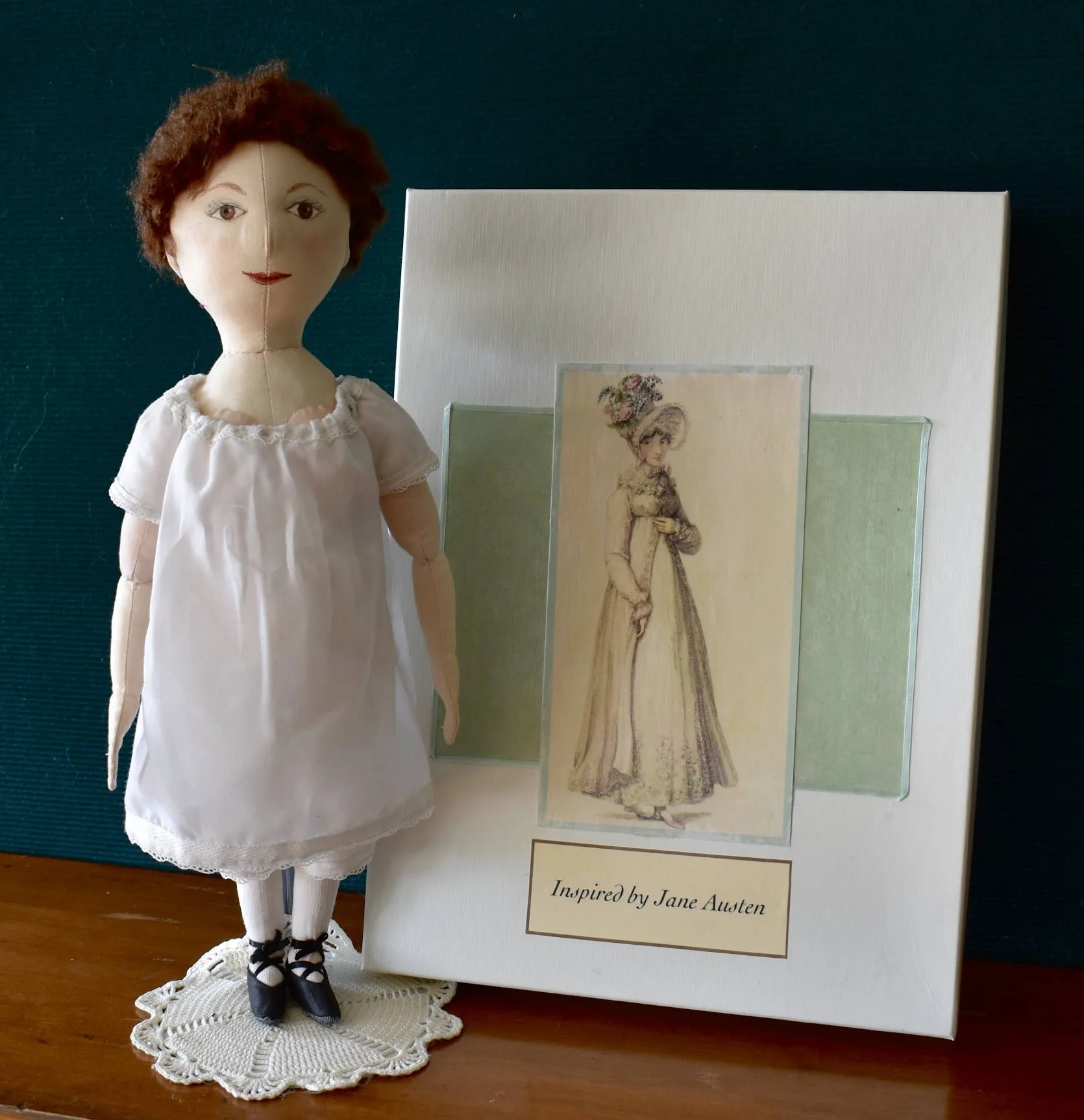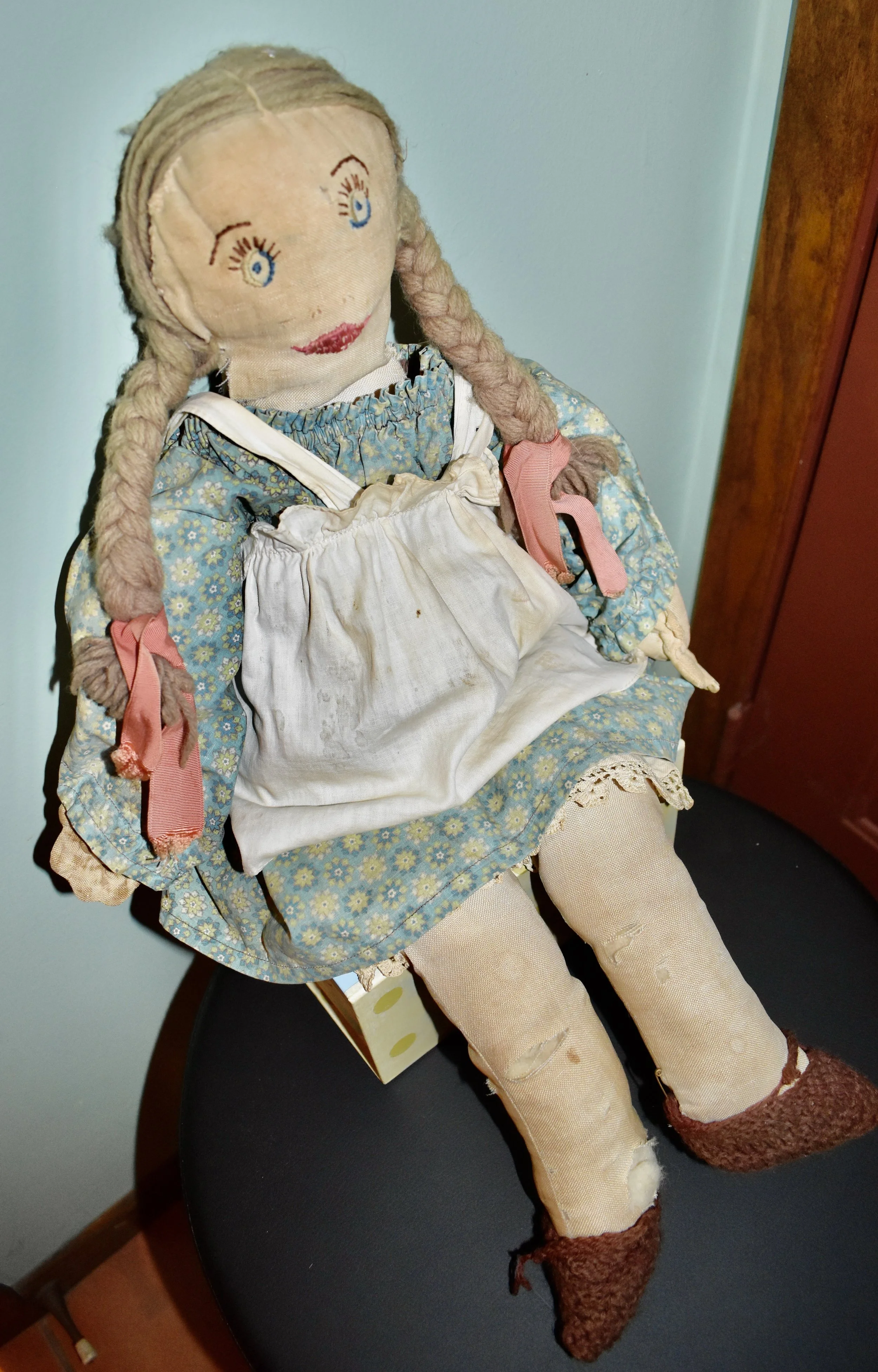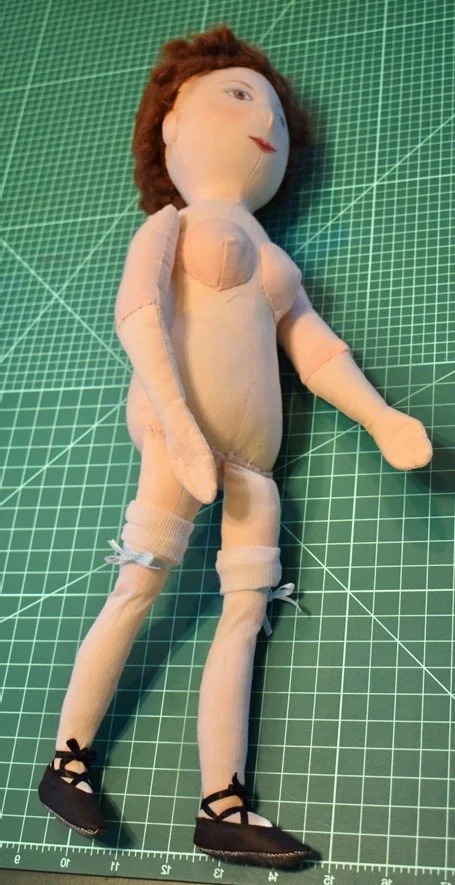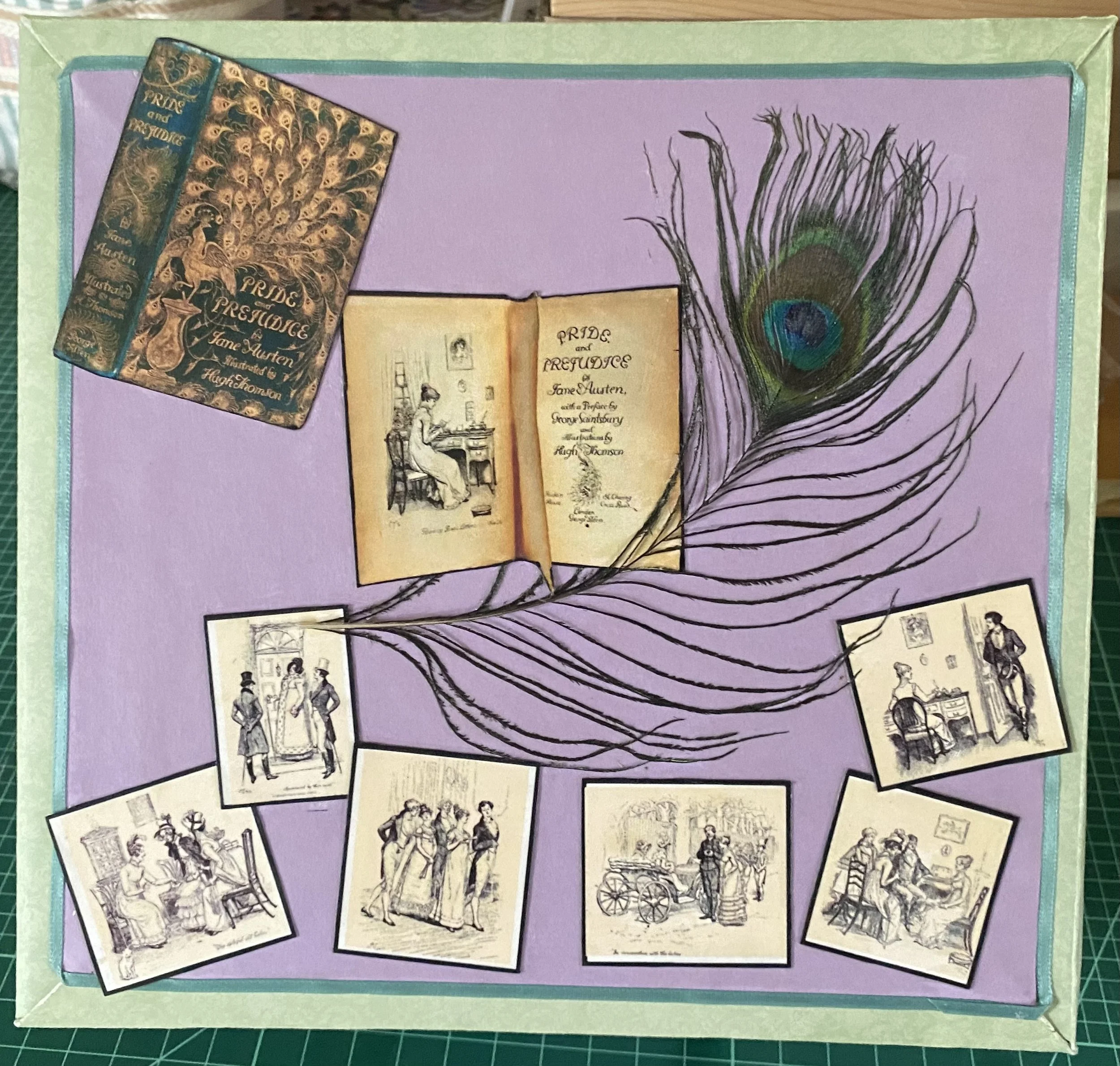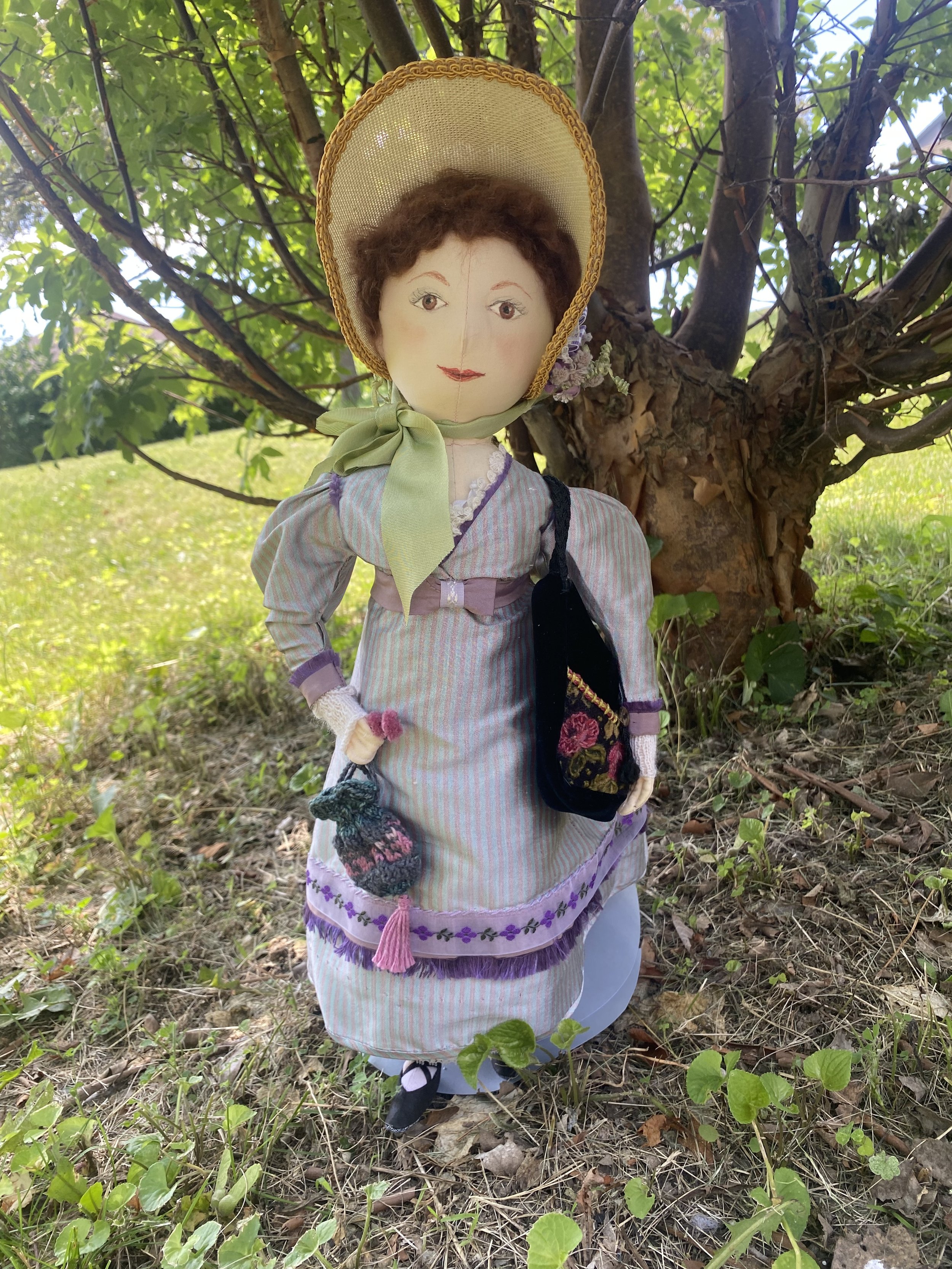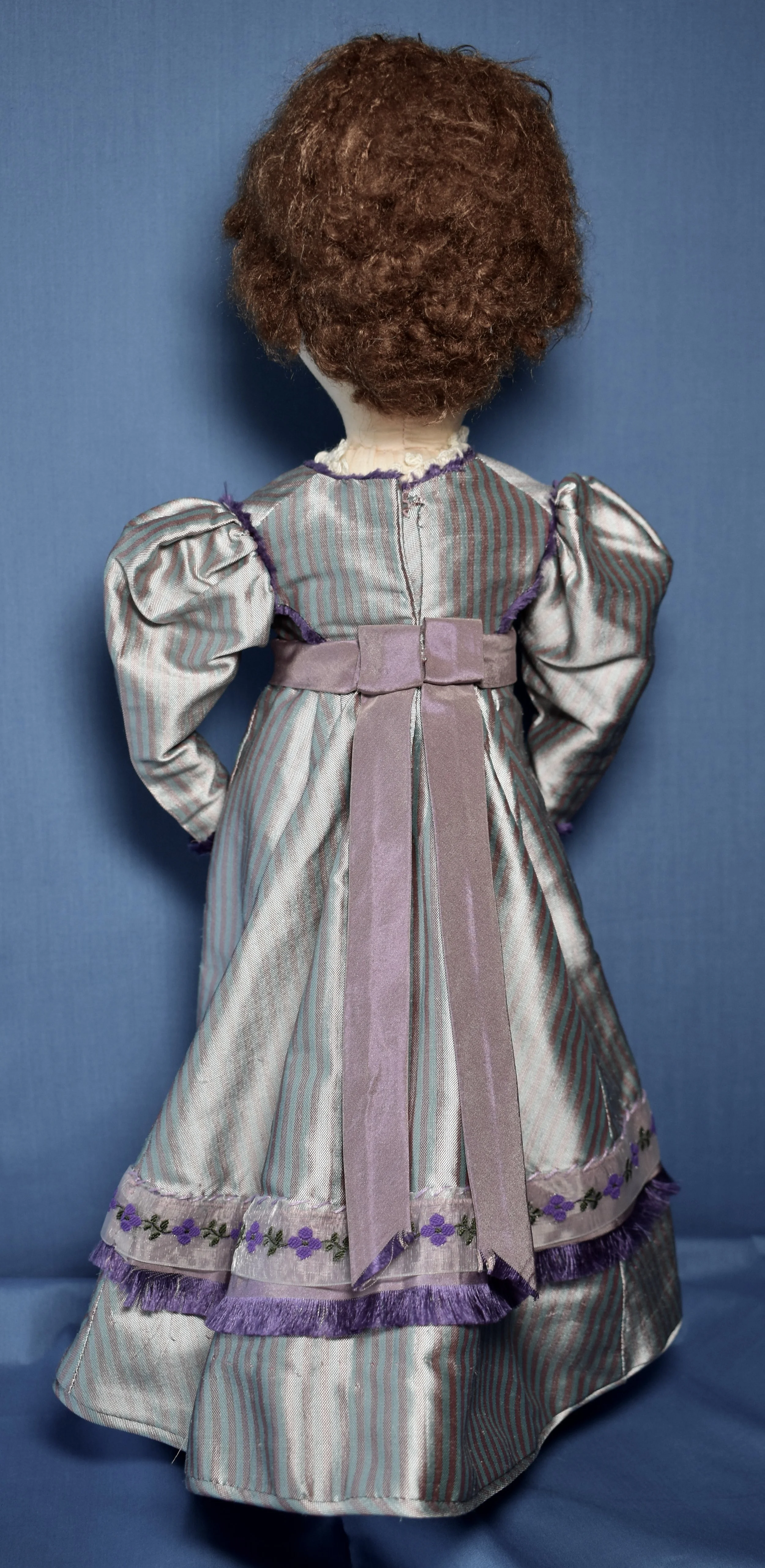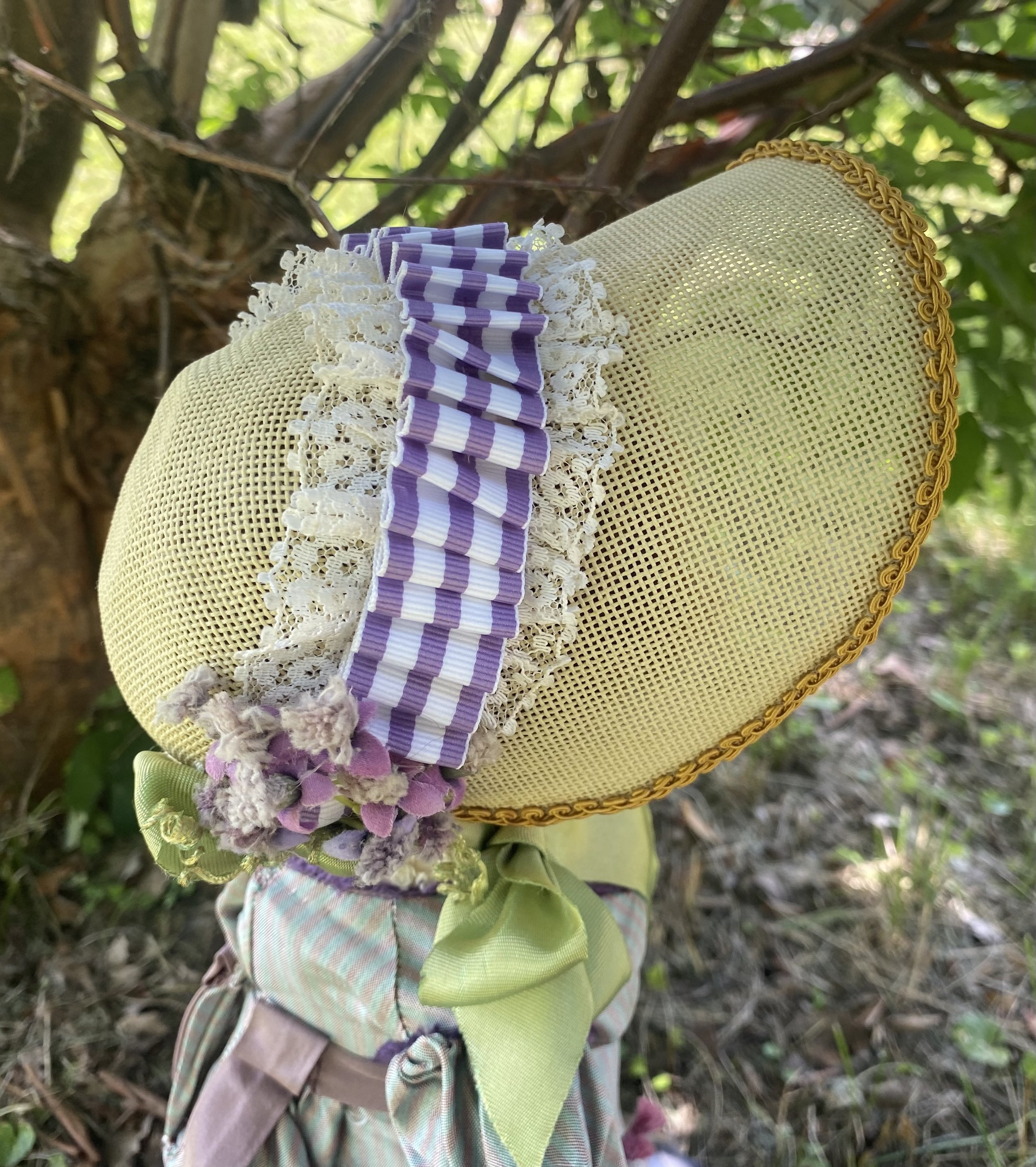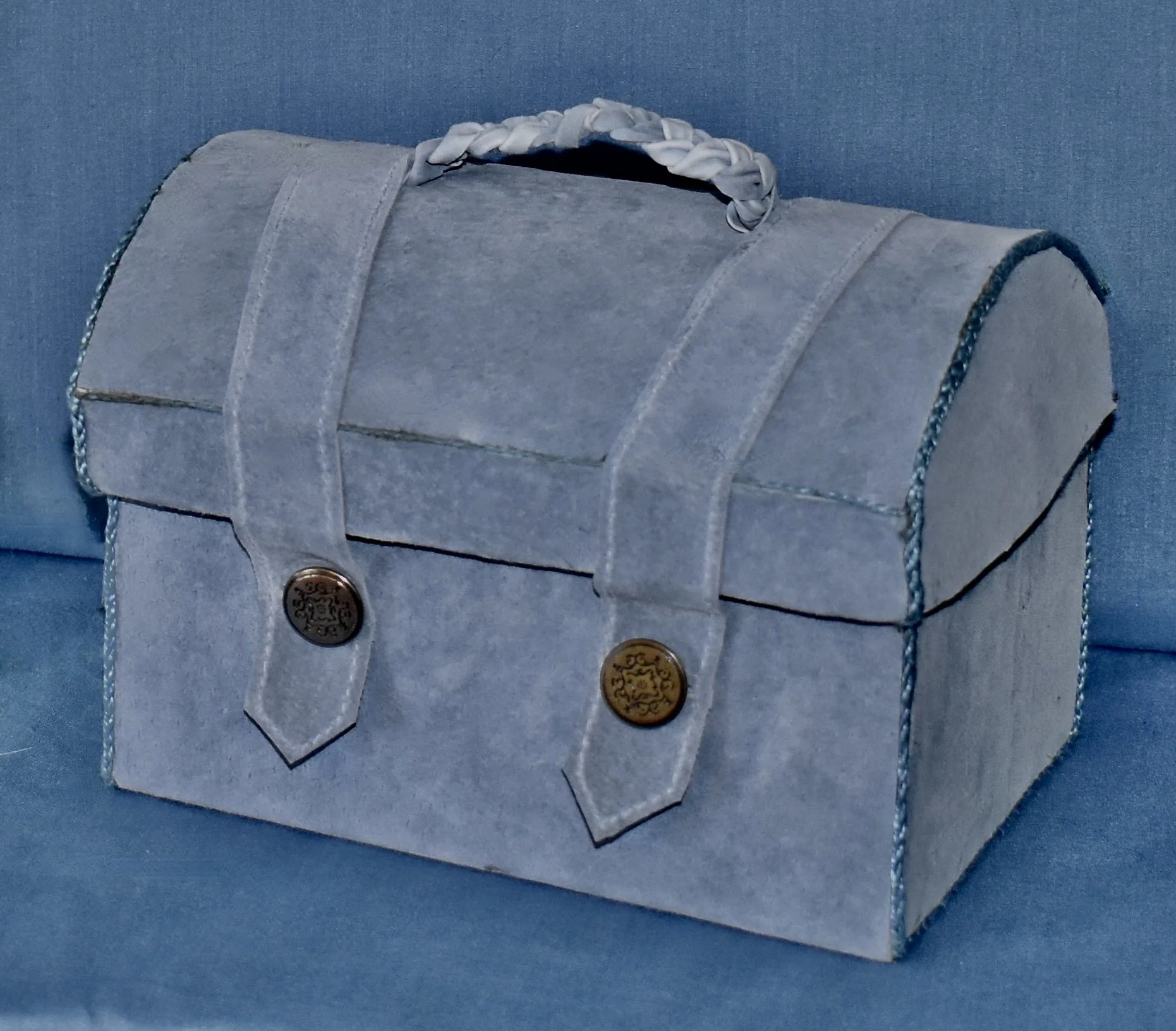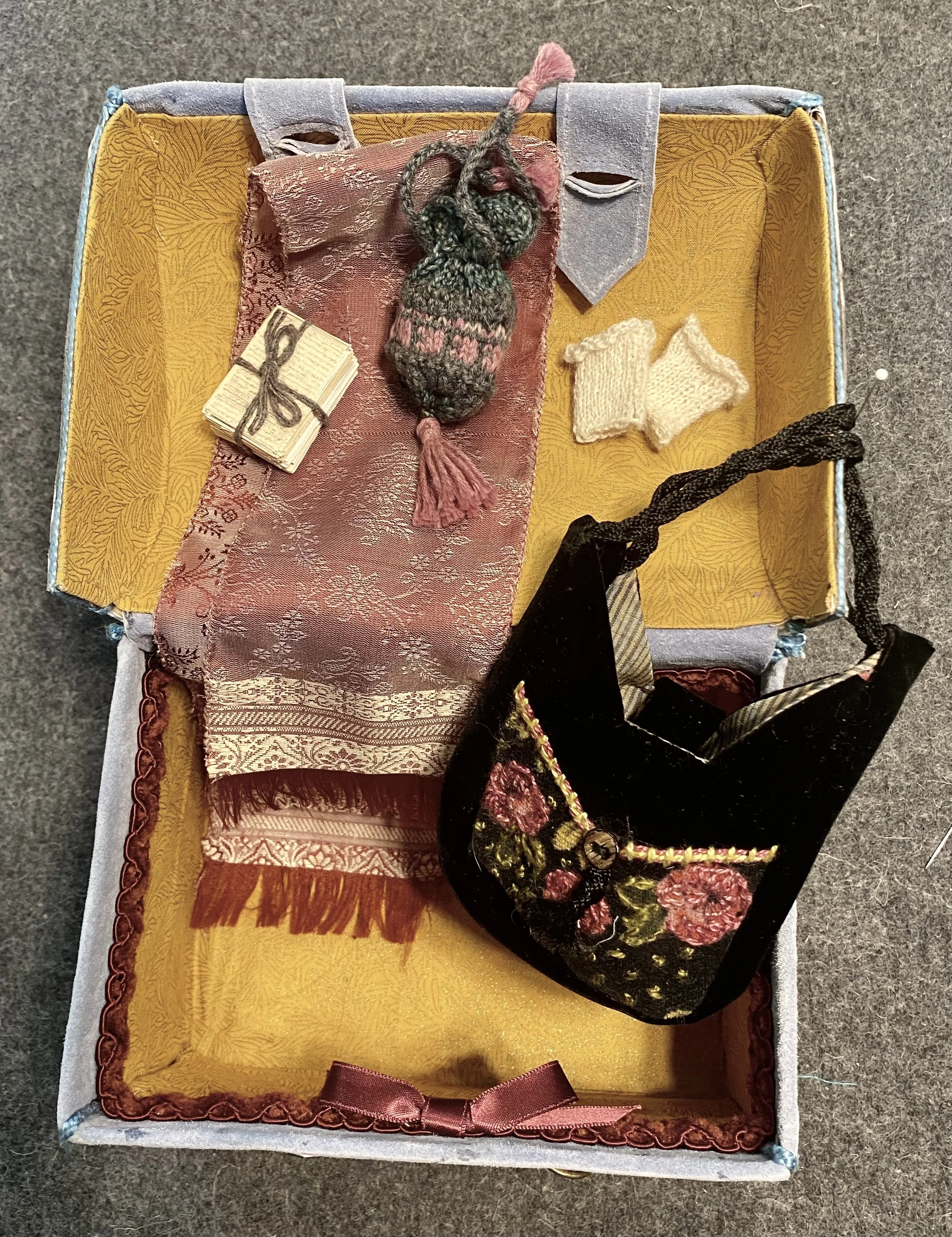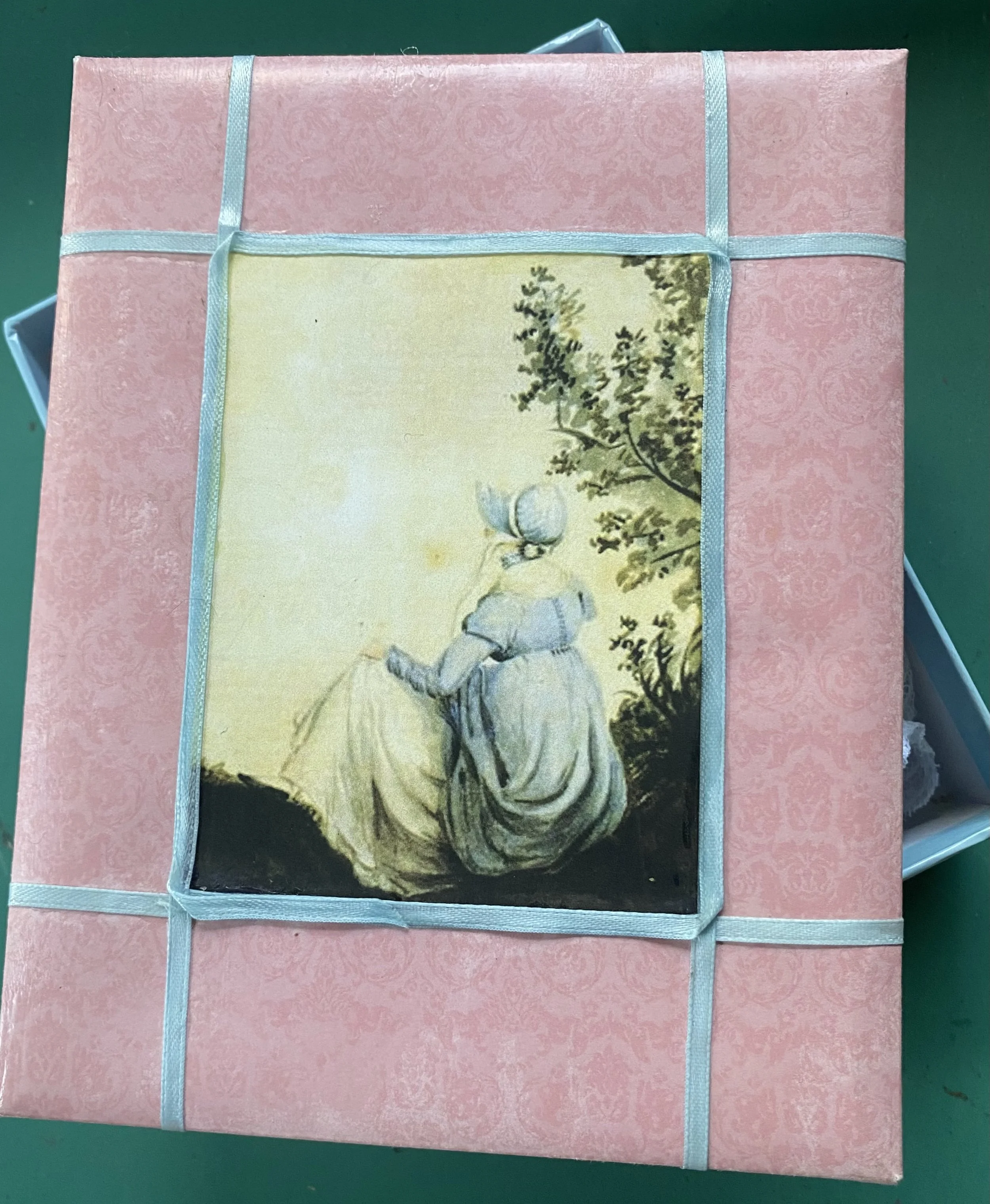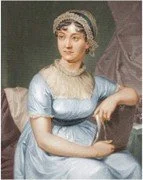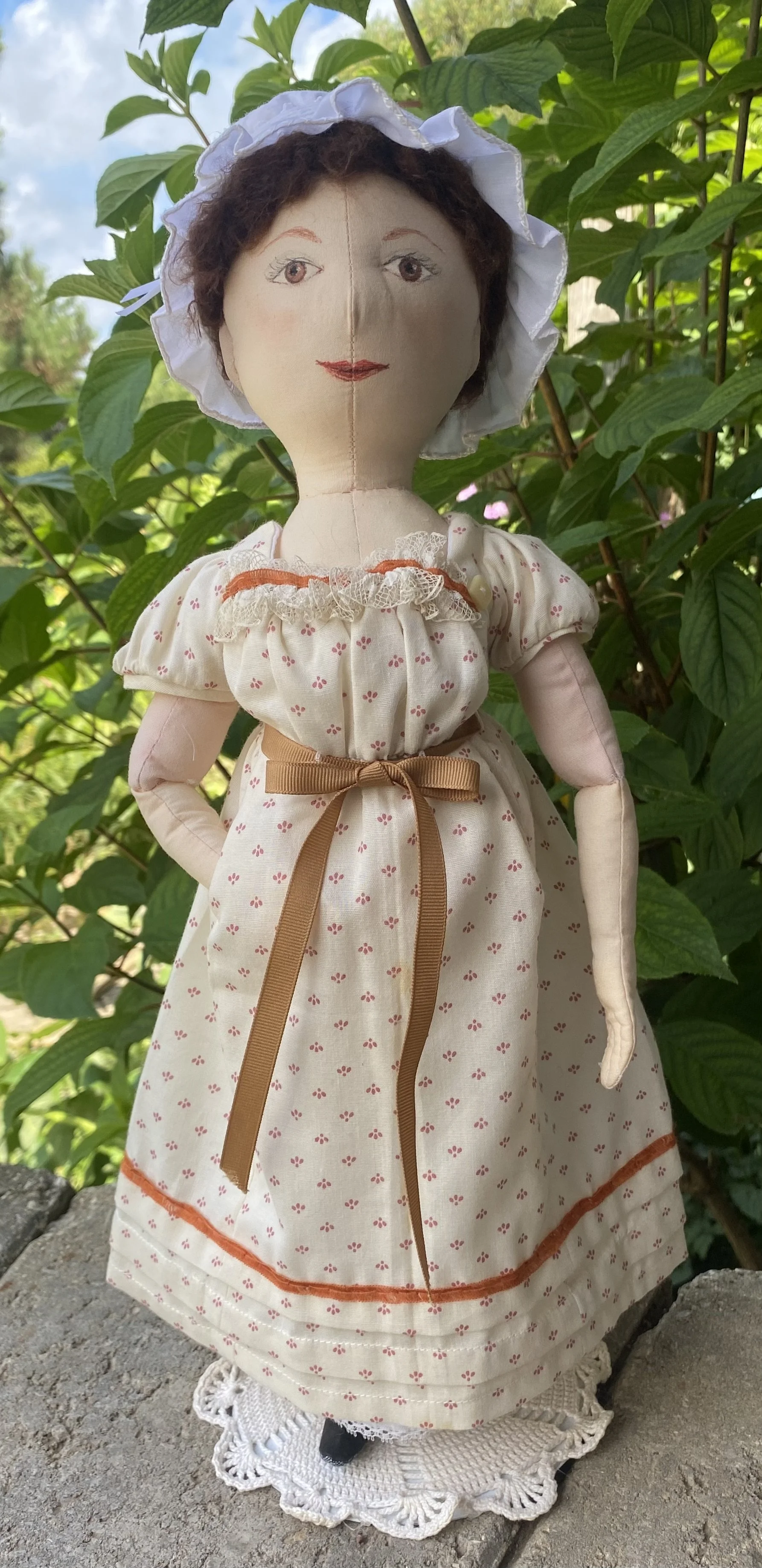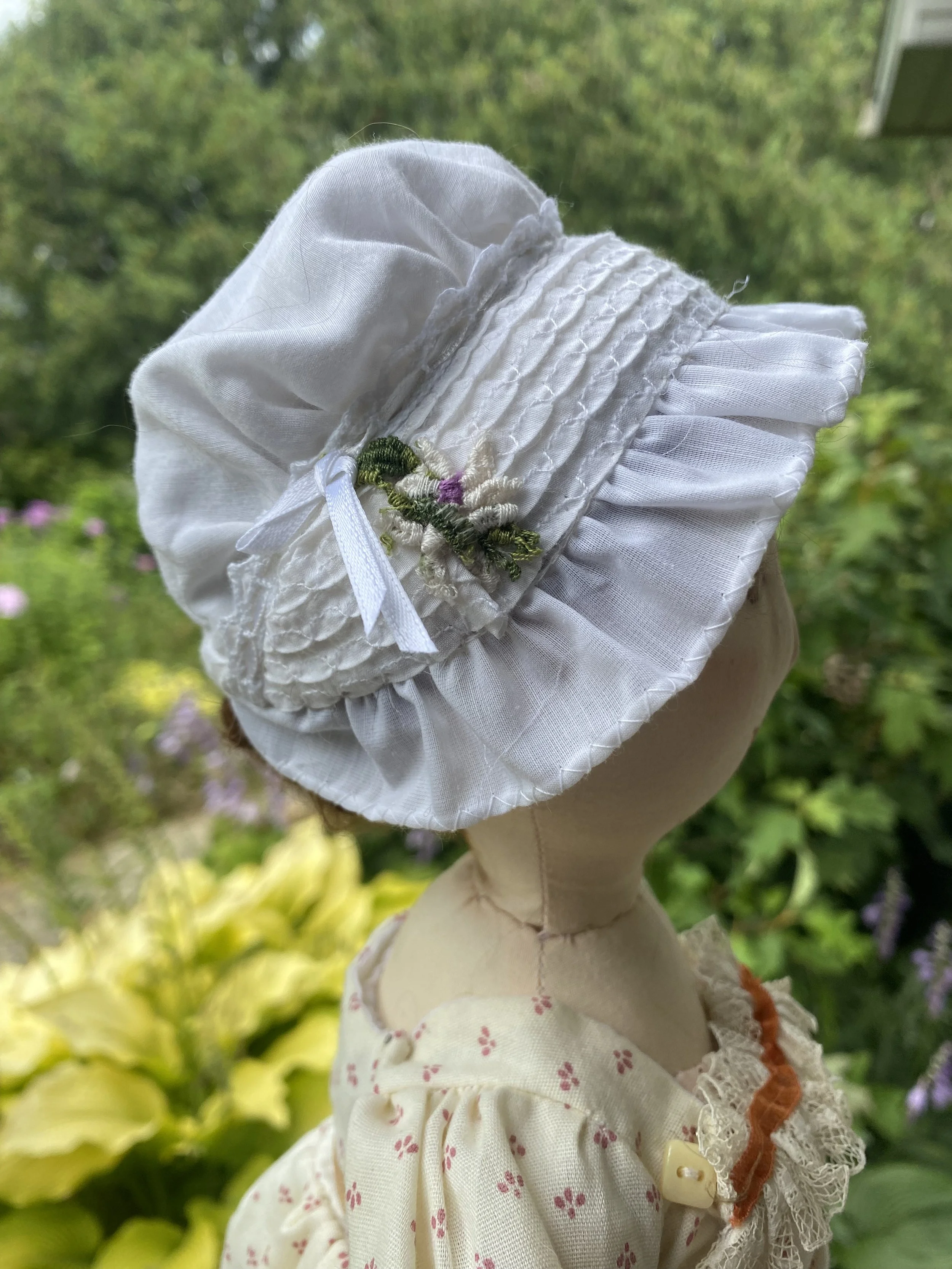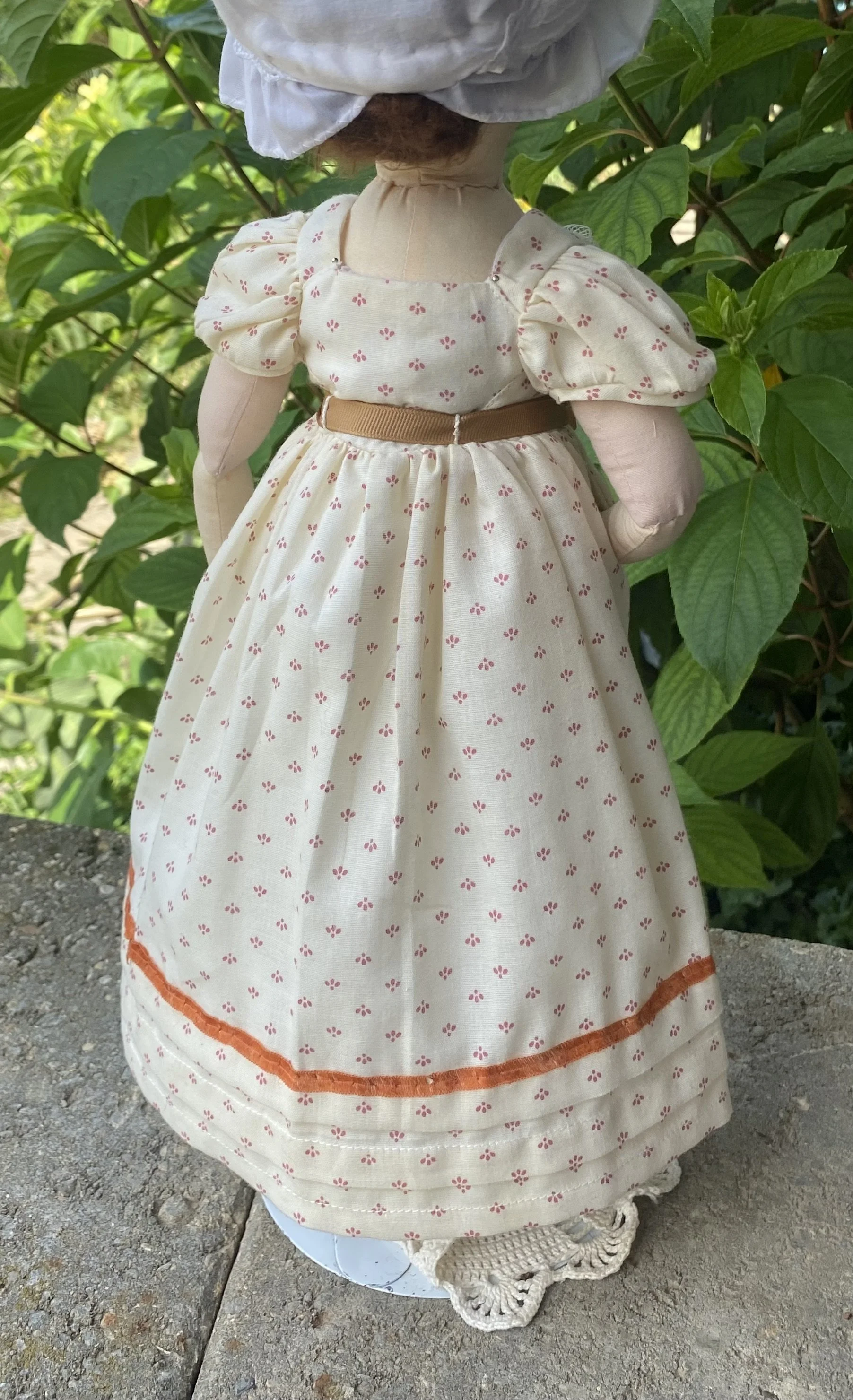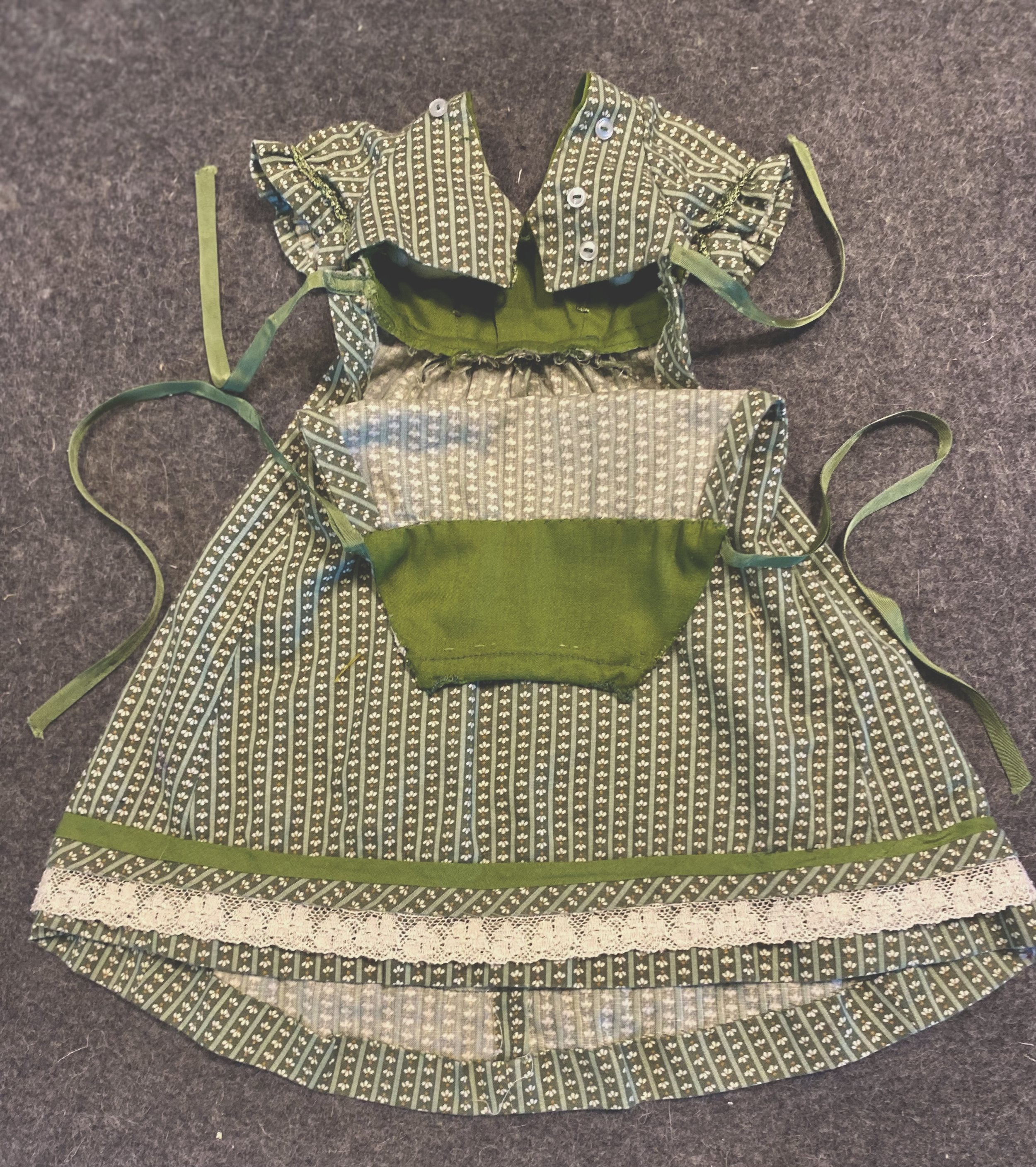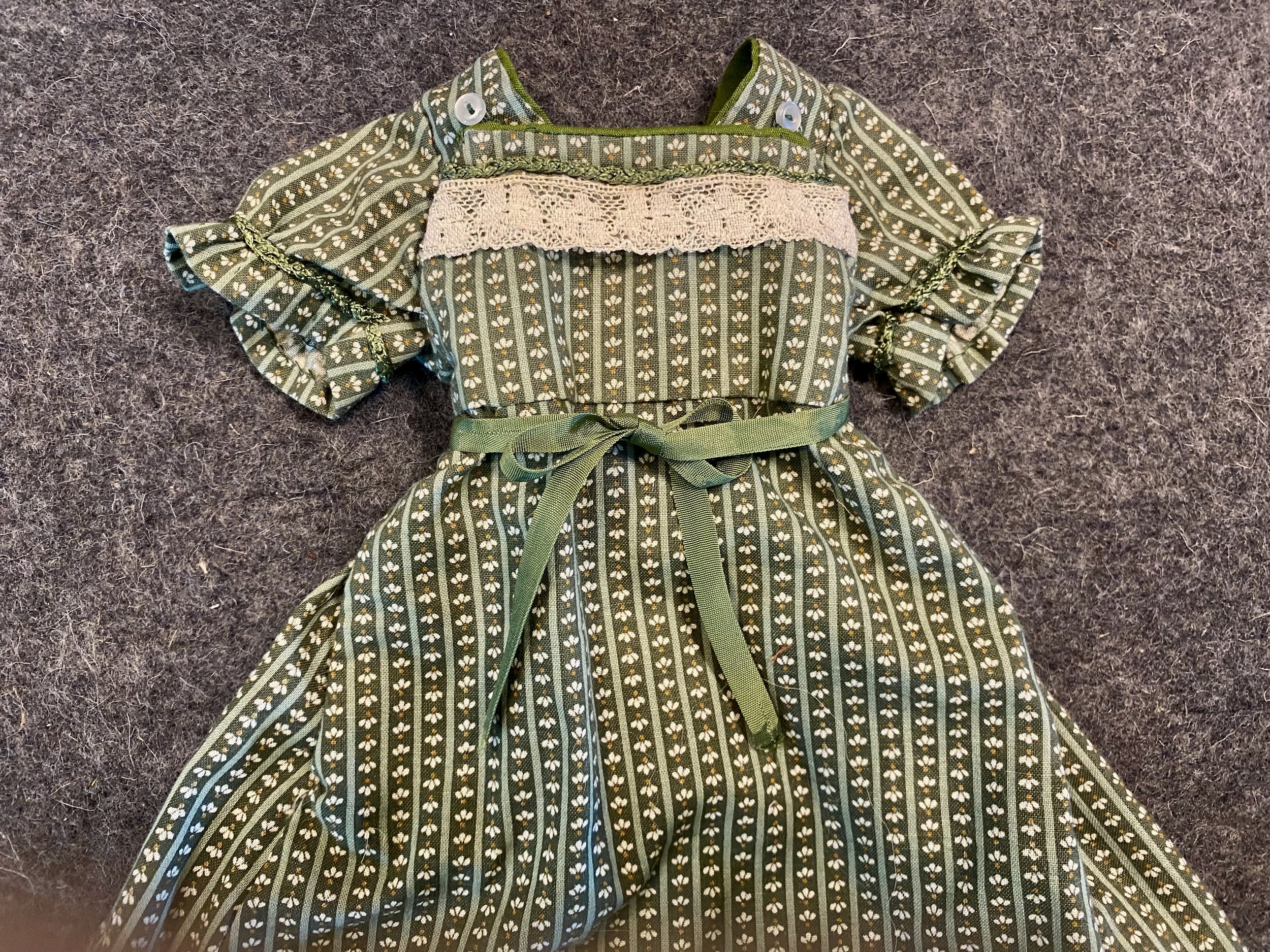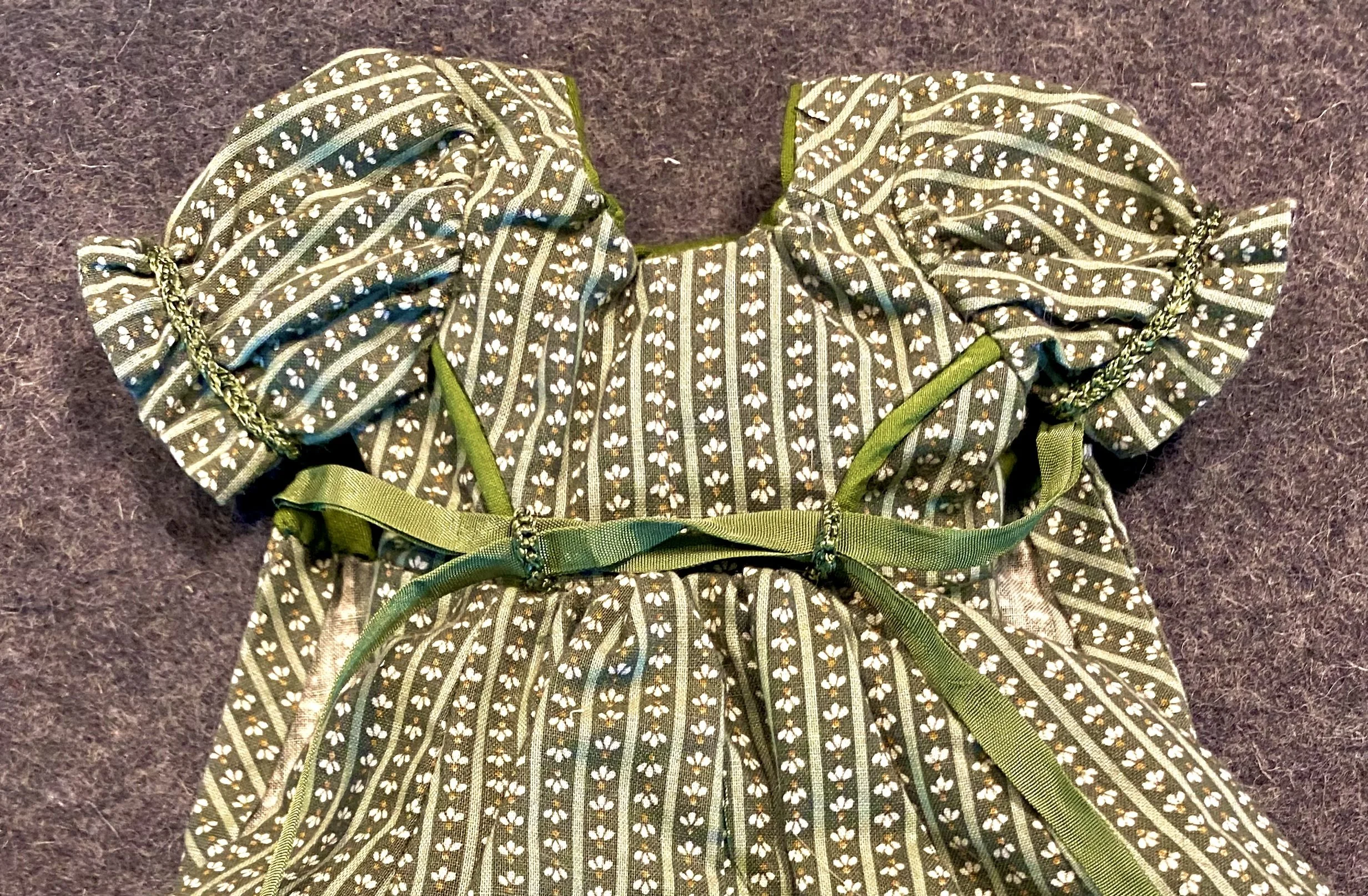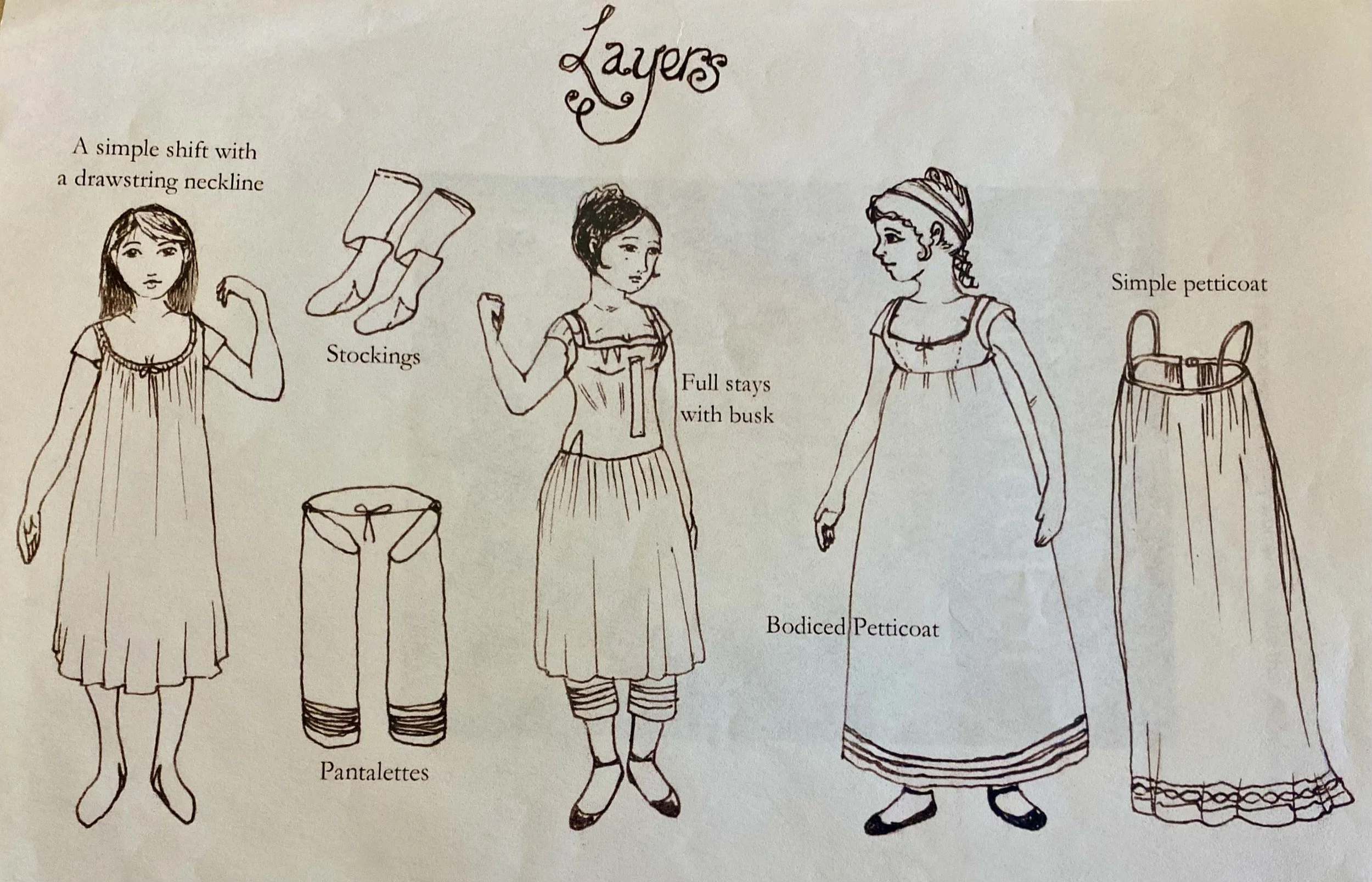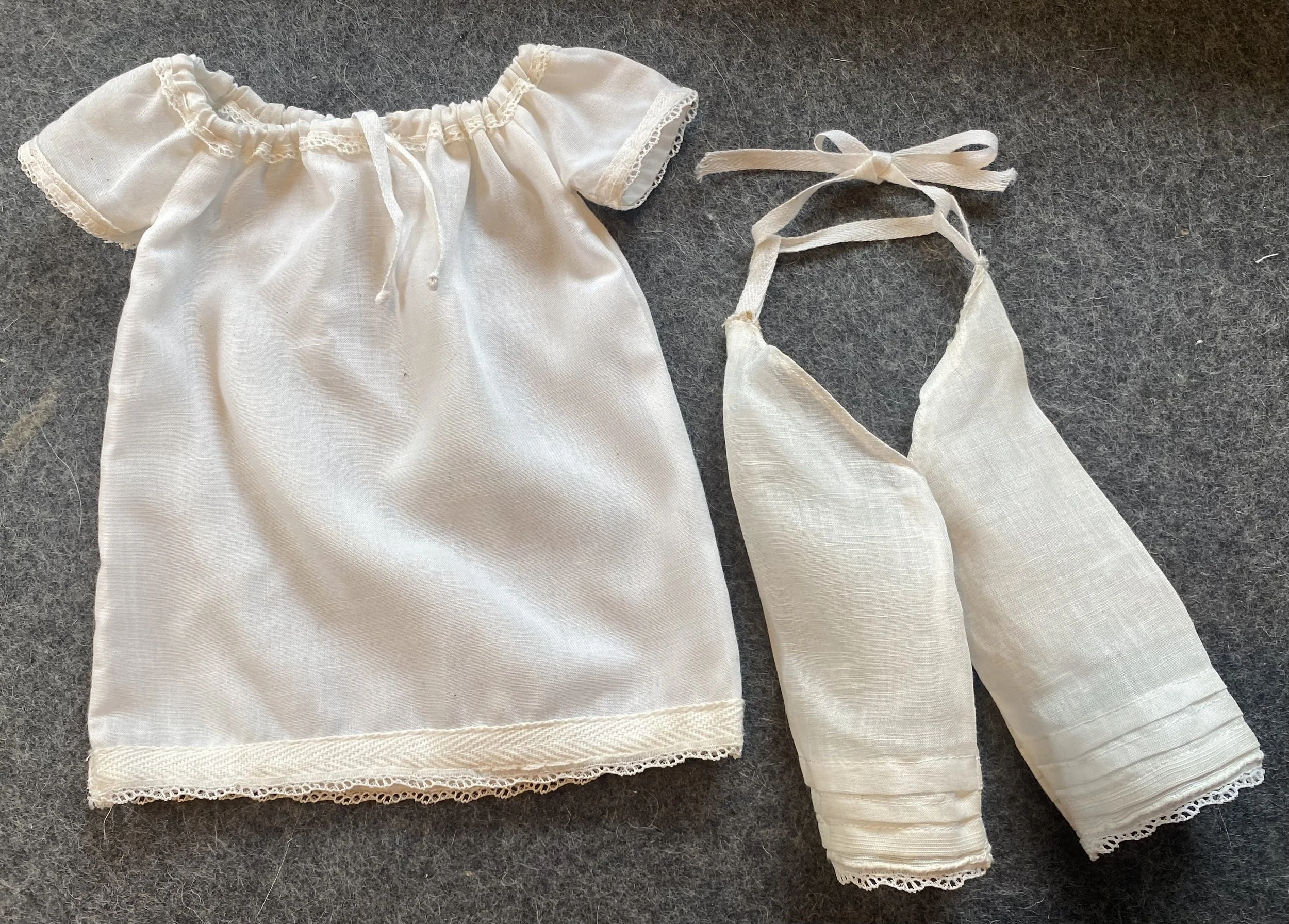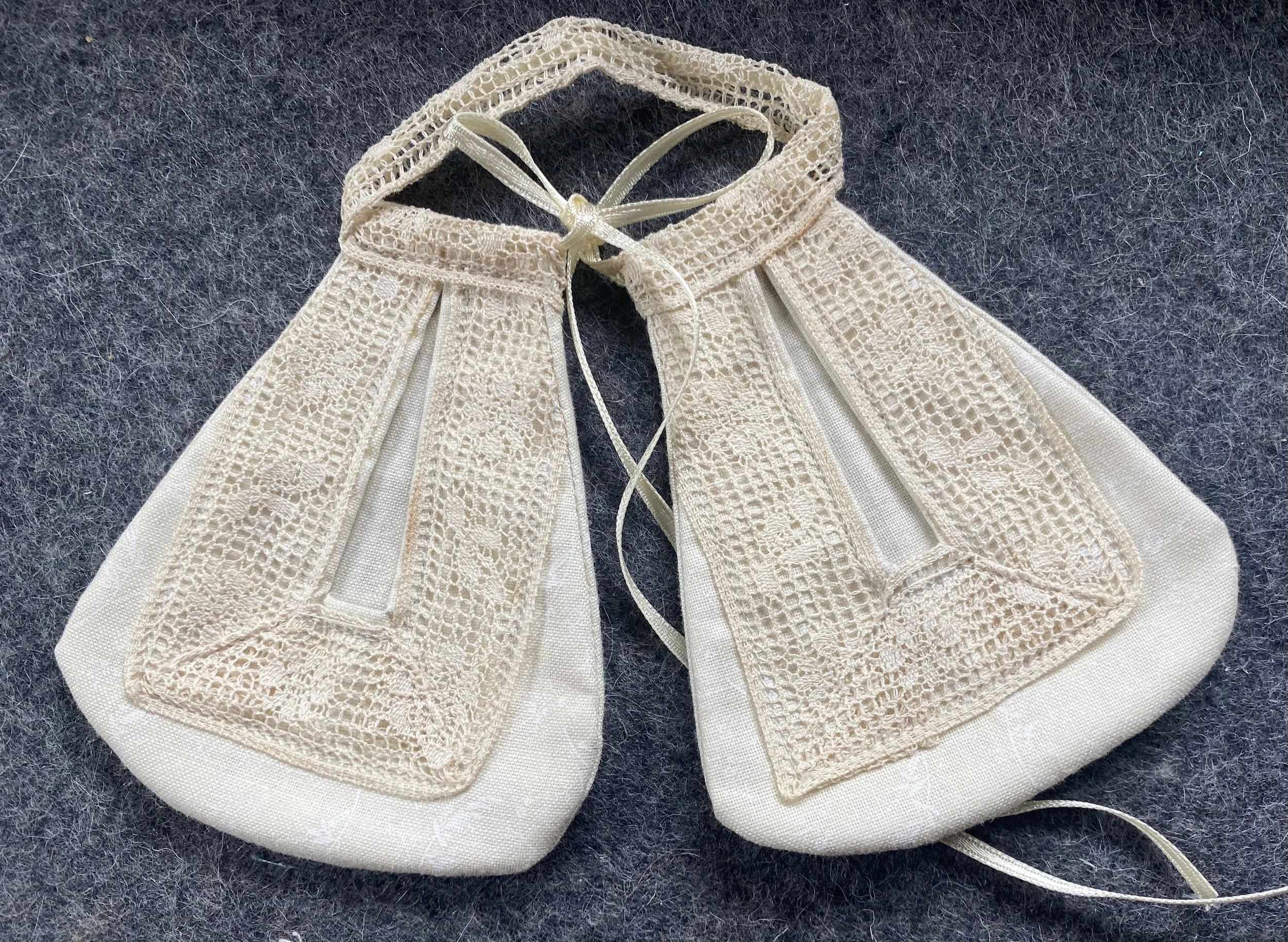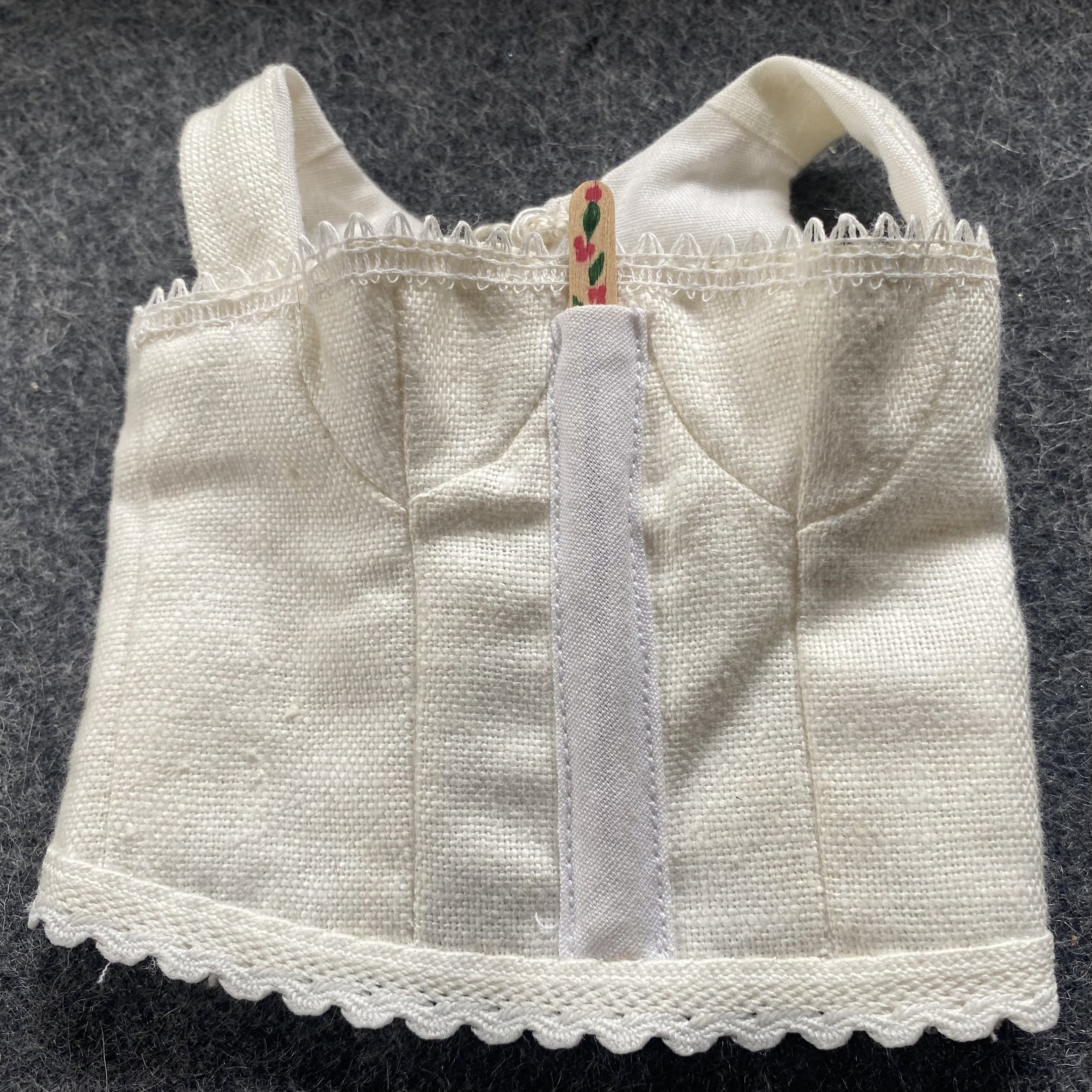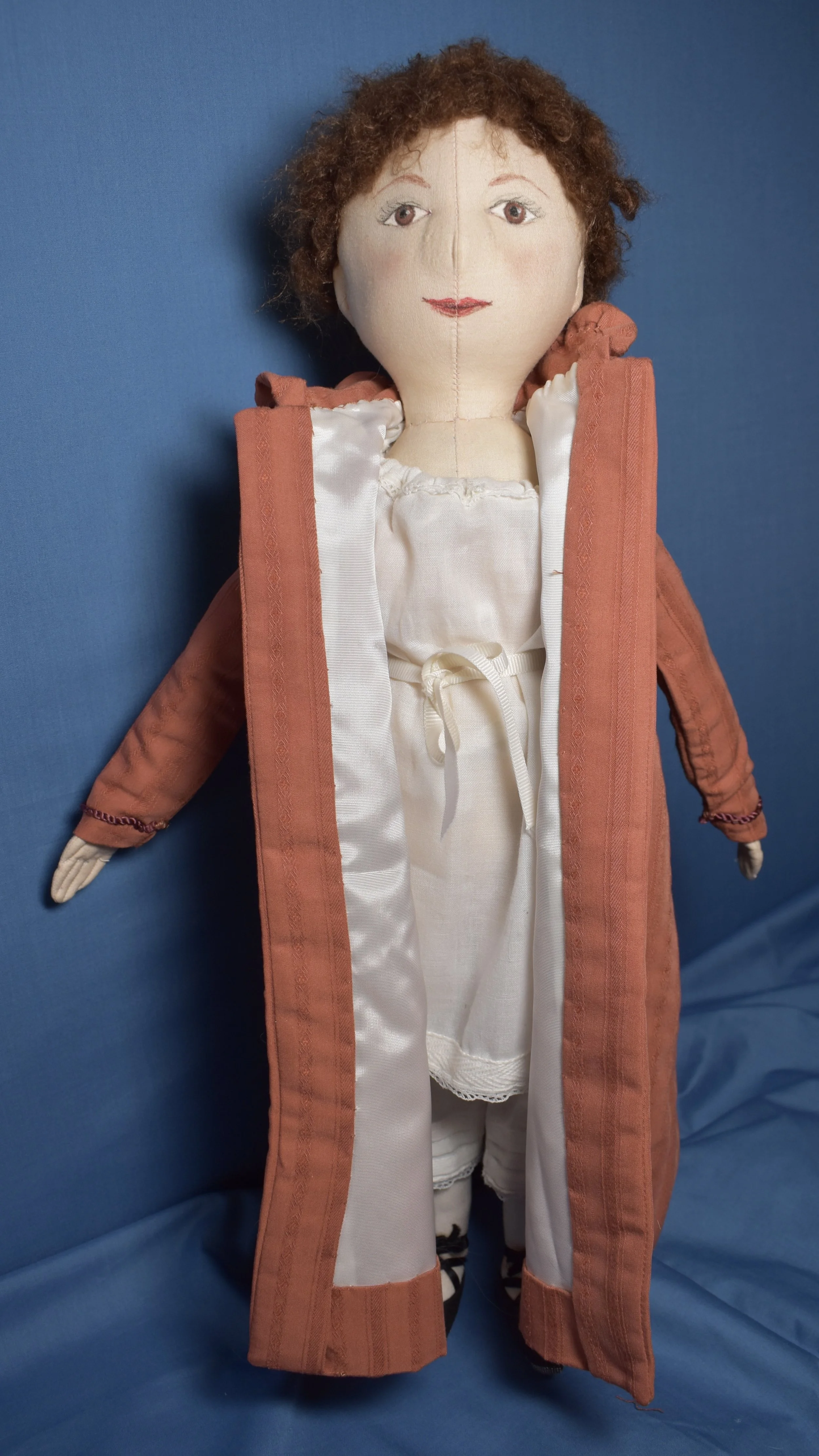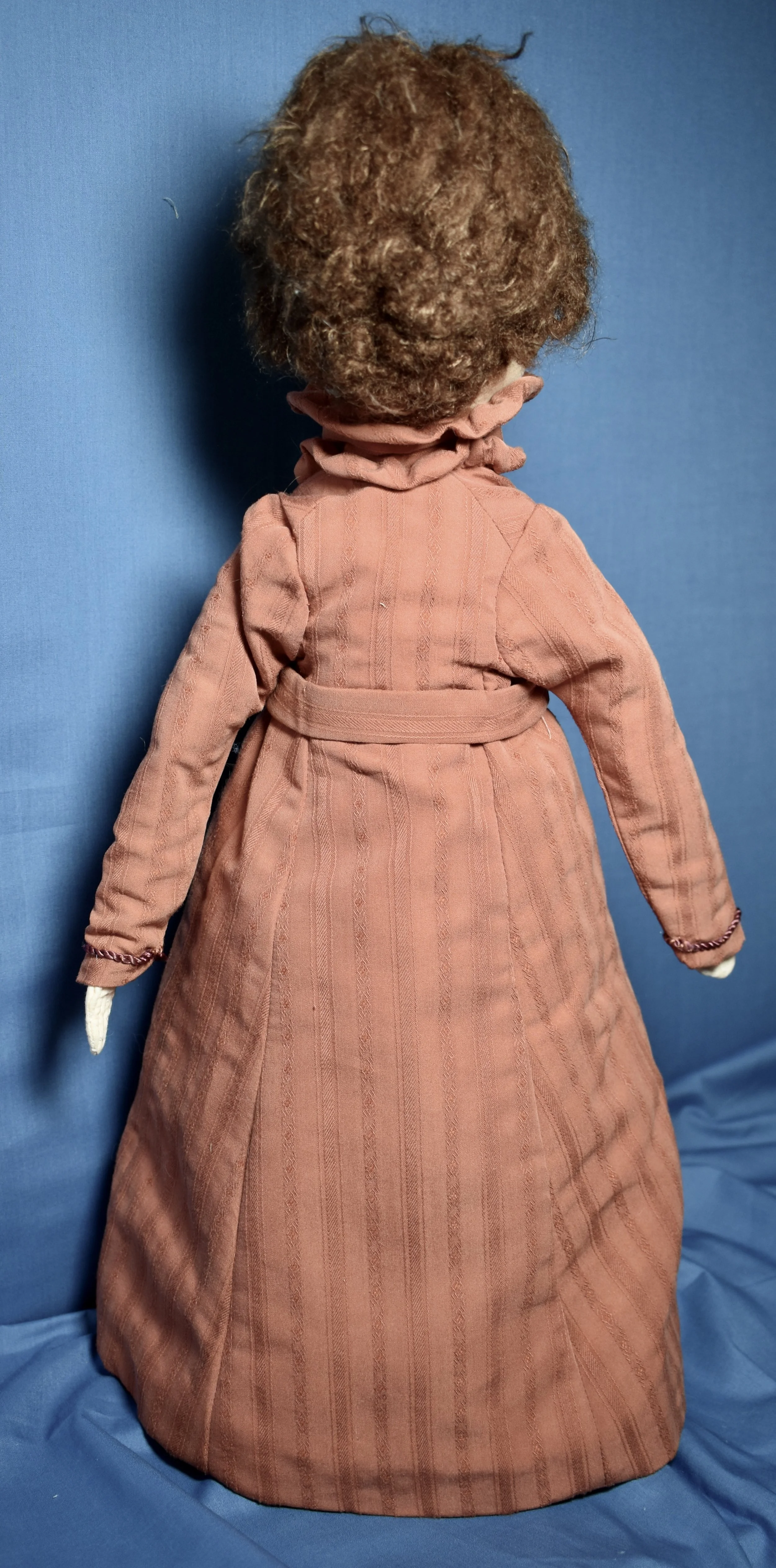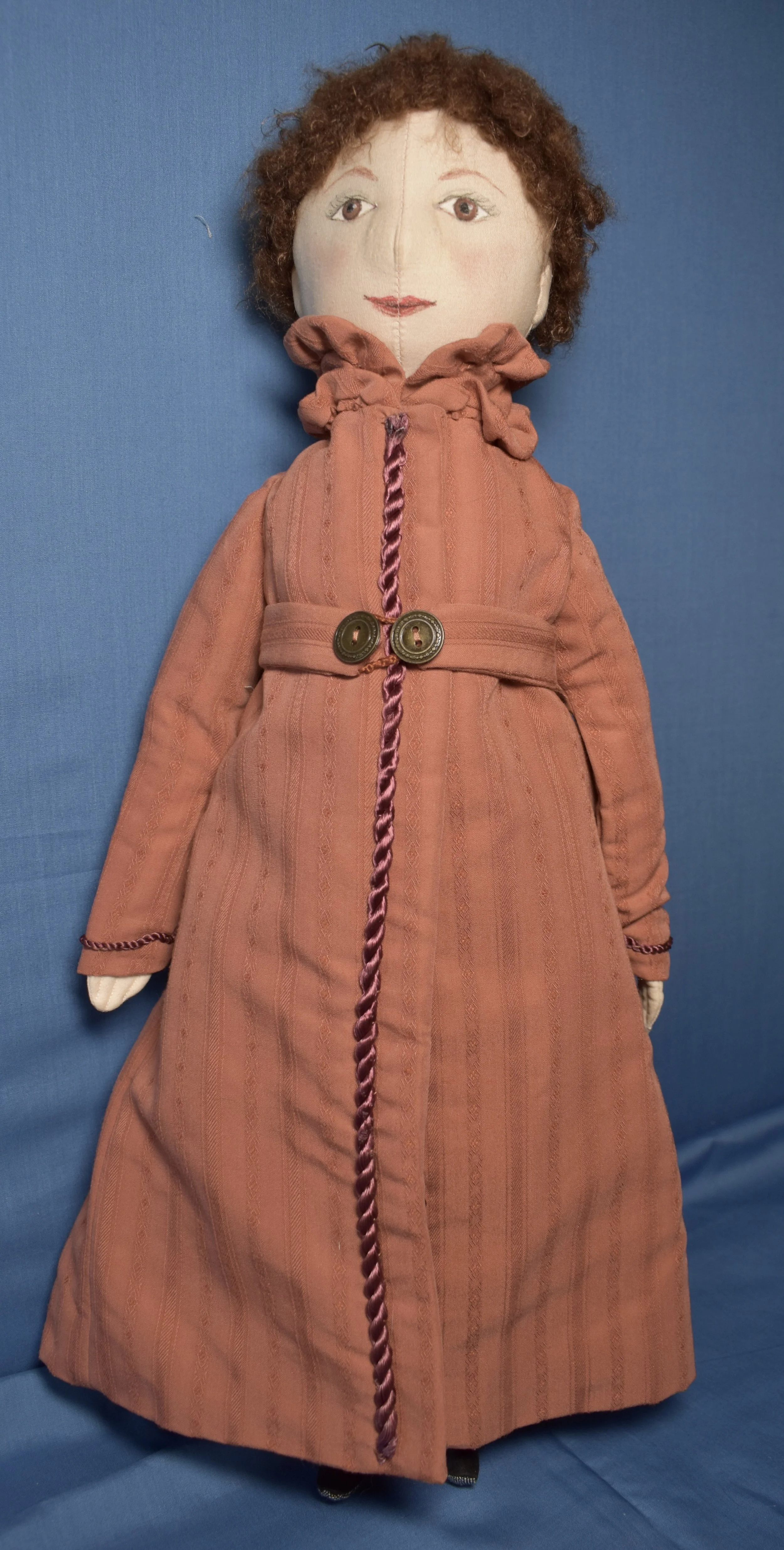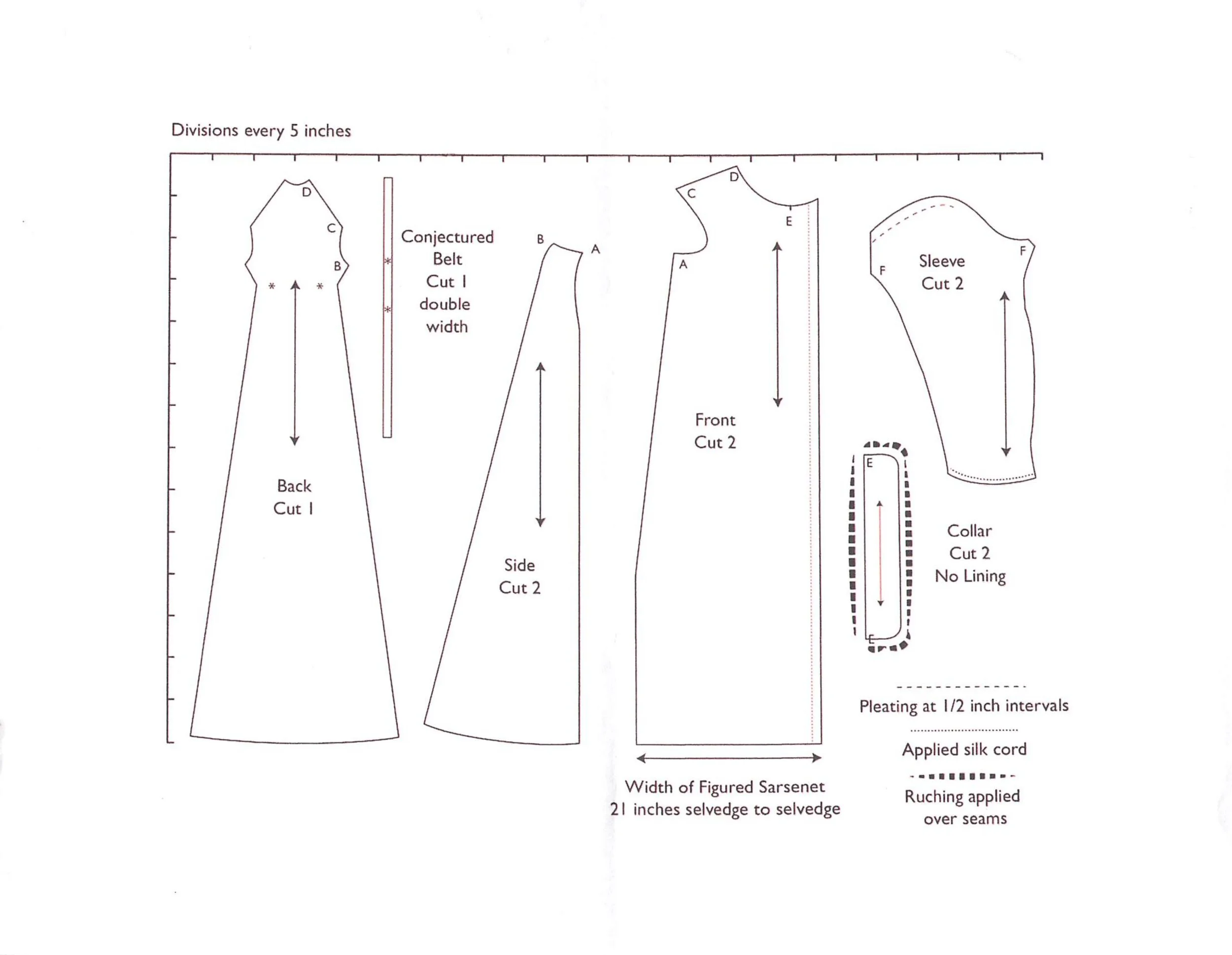JASNA Virtual Member Jeanne Vaver presents her amazing Jane Doll Collection and how she was inspired to create it by Jane Austen. Click on the white arrow to start the video. There may be up to a 22 second delay for the video to start. You can enlarge to full screen by clicking on the square at the bottom right of the video screen. In addition, there will be articles added by Jeanne on a regular basis, detailing different aspects of the collection. Check back for those often.
The doll that inspired an entire Jane Austen wardrobe collection made by Jeanne Vaver during the Pandemic
Serena, the author’s first doll who inspired her to dolls and doll clothing.
First Dress that started the “Inspired by Jane’’ Project
When I decided to dress my doll as Jane Austen, this is the image I had in mind.
I could not go shopping for the exact blue I wanted because the stores were closed due to Covid, so I had sort through my stash of fabrics. The ONLY piece of blue cotton fabric I could possibly use was a print of blue flowers on a white background, so that was that. There was just enough of it to make a doll dress.
Next step was to research Regency dress. I learned that the bodice construction in gowns was quite unique during this time period. The back of the bodice was pieced with gussets at each side. There was no shoulder seam placed as we know it today. Instead, the front fabric extended over the shoulder down to a point a short distance above the side gusset seam. This assembly allowed the fabric to mold across the shoulder blades to give the dress what seems to me to be an elegant line.
No slouching!
The high-waisted skirt could be cut as rectangles, or as shaped gores that reduced the amount of fabric gathered around the waist and allowed the skirt pieces in back to form a small “train”. Ruffles and trims were placed around the bottom of the dresses. I used a length of pleated trim edged in blue from my lace collection. (I think it looks like vintage 1930s, but that’s all I had.)
Guided by the picture, I made Jane’s sleeves without any fullness, her neckline straight across, used a ribbon for a belt at the high waist. The fichu serves as a décolleté and is separate from the dress. It opens at the back and is gathered at the neck. The dress closure was down the center of the back and because I wasn’t sure how to do this detail and couldn’t find much information at that time I winged it with three of the smallest buttons in my collection, one at the neckline and two at the waist, held closed by loops of embroidery thread.
Her cap is a large circle of fabric gathered onto a dark band that is trimmed with a dense wide ruffle. I chose to use a pink velvet ribbon only because I liked it better than any dark ribbon in my ribbon scraps and I had read that a pink ribbon was mentioned in a letter between the sisters. That was probably when I thought of this project as not anything that had to be absolutely accurate so I would say “Inspired by Jane”. Everything else was pretty close to the portrait. I was having fun and no one would know anyway.
Then four years later I am reading “Jane Austen’s Wardrobe” by Hilary Davidson, pp. 68 - 71, about the “c.1805 - 10 Portrait Gown” and learn that everything about this dress and cap depicted by the artist, that I copied diligently and did not think to question, is wrong!
So you can wait for the explanation which I will write up at the conclusion of this project OR you can get the book (it’s a treasure) and find out for yourself. That’s what a Janite would do, right?
Jane’s Underclothes
When Jane’s first dress was ready for a “fitting” I realized that she would have to have undergarments to give the dress shape. At the same time I came across this illustration that suggested more than just a petticoat would be needed. Jane should have stockings, a shift, pantaloons, a corset and possibly multiple petticoats. Later I learned that she would have worn “pockets” under her dress.
Instead of using a lightweight cotton, I should have made Jane’s shift from linen, because in Regency life the shift was made of substantial cloth since it was worn constantly and laundered often. The shift was worn to protect the dress fabrics from body oils and dirt. Middle and upperclass women owned a collection of shifts. Shifts were constructed so simply that multiple shifts could be sewn by the wearer instead of by a dressmaker. Each shift was embroidered with the owner’s initials and a number, so it could be counted when it was sent to be laundered and again when returned. (I intend to add this detail to Jane’s shift when I have a minute.)
Jane Austen may have worn the first version of pantalettes, which were two separate “legs” joined together and held at the waist with a drawstring. “An anecdote from Susan J. Vincent’s book The Anatomy of Fashion (2009) recounts how a stylish princess wore her pantalettes in 1811 when fifteen-year-old Princess Charlotte, the rather racy daughter of George IV and Queen Caroline, had adopted them”. Information is sparse about pantalettes, probably because they do not show up in archived collections. A few begin to appear in 1830 when the two pieces have become one article of clothing.
This copy of a very early corset is made from linen, is lined, and laces down the back, with just one strand of cord. Down the front, between the breasts, is a long narrow pocket that holds a “busk”. a long flat object made of metal, wood, or ivory, perhaps elaborately decorated. The busk prevented slouching and required the woman bending over to do this from the hips, not the waist. (Try that all day, every day!) Jane’s busk here is painted with sprigs of pink flowers.
Her multiple petticoats could have been made from lightweight cotton for summer, heavy flannel for winter, plain cotton for everyday, or fine fabrics for special occasions. Petticoats could be attached to a bodice, or have straps to hold them high under the bust. Some were worn to be seen as an underlay in the costume.
I was totally unaware of pockets, an accessory worn by women for more than 200 years, hidden from view under the dress, until I discovered the book “The Pocket A Hidden History of Women’s Lives 1660 - 1900” by Barbara Burman and Ariane Fennitaux, c 2019. Women were not privileged to own property or have their own money and rarely had a room they could call their own. Because women did not have any means of security other than perhaps a locked drawer, they carried their “valuables” on their body in hidden pockets. These pockets could range in size from small to pockets as large as pillowcases. A pair of pockets was tied at each side of the waist, positioned over the petticoat, and accessed through side slits in the skirt fabric.
For a much more detailed journey into this only recently researched women’s history topic, treat yourself, or use the library, to read “The Pocket” by Burman and Fennetaux:
’In this riveting book, the authors take advantage of the pockets’ frequent survival in textile museums, private collections and family holdings across Britain, tracing their presence in art, literature, political satire, domestic organization and court records. In the entwining of art, social and material history, few stones are left unturned.’ Roberta Smith’s Top Art Books of 2019, The New York Times
‘What particularly interests Burman and Fennetauz is the way in which women of all classes have historically used these tie-on pockets as a supplementary body part to help them negotiate their way through a world that was not built to suit them’ Kathryn Hughes, Guardian
Jane’s underclothes are stored in a box decorated with images from the Peacock Edition of “Pride and Prejudice”. Researching images related to Jane Austen and her books and then finding a way to use the images turned out to be another excuse to be crafty. (Anything to avoid cooking and cleaning!)
Drop-Front Dresses
Knowing that I would be writing about “drop front dresses”, I searched my
brain for the word that would describe how I felt when I first came across a
diagram that explained how this unusual Regency dress construction
worked.
I decided that I was…..flabbergasted!
This kind of dress construction is incredible! The gown would have been
easy to slip on over the head - no other person would be needed to fasten
buttons down the back. The ties made the waist completely adjustable, in
the case of pregnancy, perhaps. The under-bodice was held closed with
straight pins or lacing, another easy adjustment that must have been
convenient when breastfeeding an infant.
The woman wearing this dress would have stepped into or pulled the dress
over her head, put her arms into the sleeves, then tied the ribbons sewn to
each side of the skirt into a bow at the center to secure the skirt closure.
She would have fastened the side pieces of the under-bodice together with
pins or lacing, and then raised the dropped front to fasten the two buttons
at each side in the front. Doing this would hide the pinned under-bodice.
The long ribbons, positioned where the bodice is attached to the skirt,
would each go around the waist, one left, one right, to the back, cross at
the back through loops to guide the ribbons, and on around to meet again,
where they would end in a tied bow at the waist on the outside of the dress.
Because there were no seams attaching the front panel to the side panels
at the top portion of the skirt, openings were created at each side that
allowed easy access to pockets. Before donning this dress, she would
have already tied her pockets around her waist on top of the petticoat.
Now they were safely hidden in the folds of her dress skirt.
This dress construction could also be known as “apron front”, “fall-front’,
and “bib front”, according to Hilary Davidson, (“Jane Austen’s Wardrobe”, p
33), which, as she points out, are modern ways to describe these dresses.
They are not mentioned in Regency sources, so we don’t really know what
they were called back then, even though they were common and prevalent
in Regency fashion after 1790.
Mostly this kind of dress construction was used for day dresses, although I
did read that some collections have examples of ball gowns with dropped
fronts.
Inspired Jane is pictured wearing one of her everyday caps. Wearing a cap
morning AND evening marked a woman’s transition from youth to elder,
(middile age was barely recognized) but we know that the real Jane
consistently wore caps morning and evening at an early age because it
saved much time having to fuss with her hair.*
These caps were created with much imagination, with lace, ribbons, and
perhaps flowers, so I was free to do whatever with what scraps I had on
hand. I made two more caps that were quick to sew but now look to me as
though they need some more decoration. I must add this fun task to a list
and hope to get to it soon.
The caps are collected in a box featuring a drawing attributed to
Cassandra, of Jane resting during a walk in the country. Recreating this
blue bonnet and dress is another project that I plan to do in the future.
Source: “Jane Austen’s Wardrobe” by Hillary Davidson, p.121
How my “Inspired by Jane” Project Began
In the very early months of Covid in 2020, everything shut down. There were no places to go because almost nothing was open. However, being stuck in the house presented plenty of options for keeping busy, including going to the storage room for a big job of sorting and discarding or saving forgotten treasures. On a bottom shelf I found a big box that held the handmade dolls I had made in the past. As soon as I took out this particular doll, previously dressed as “Little Bo Peep”, I was reminded of Jane Austen.
She wasn’t particularly pretty, her nose was hardly there, but she looked intelligent, and she had fuzzy brown hair arranged in a bun at the nape of her neck. She was wearing little black slippers like the tiny feet depicted in Regency fashion plates. I immediately knew that she needed a dress to make her into Jane Austen.
This first idea turned into a perfect project for me because it allowed me to play with a doll, sew doll clothes, and would require researching, a task that always energizes me.
Dolls
The first doll I remember was the doll my mother made for me in 1945, for my fourth birthday. I named her Serena and she has always been with me. She made me into a “doll person”. A few years on I would get one new doll a year, always from Santa, until I was 10 years old. I had learned how to be a mother to my dolls from the Raggedy Ann books by Johnnie Gruelle, where Marcella, the mistress of so many dolls, was always washing their clothes and hanging them out to dry., but none of my dolls ever had an extra dress or a nightgown. In second grade I was friends with Esther Ann, only because if I were invited to play at her house after school her mother would give us pieces of fabric to sew a doll dress. Neither of us got any further than cutting out a square, threading a needle (challenge!) and learning to take a few running stitches to hold two pieces together, and then inevitably it was time to walk home before it got dark. But “dolls” and “sewing” were planted in my brain.
Sewing
Now I’ll tell you how I learned to sew. I grew up In a rural town in Iowa (one flashing stop light). There were 29 in my grade. Most of us started together in kindergarten and ended together as high school graduates in just this one school building. As Freshmen in High School every girl automatically was registered for Home Economics I; there was no other choice. Mrs. Cling was the teacher, with a REPUTATION handed down from all the girls in grades that came before ours. In sixth grade we were figuring out if Mrs. Cling would be retired by the time we were in high school. No such luck even though we thought she was an “old lady”. First semester was sewing, and we had to learn the 200 parts of the electric sewing machine before we could sit down in front of one. We were challenged to make a sampler of five different kinds of buttonholes, stitched by hand with red thread on yellow fabric and every buttonhole had to be lined up perfectly. For our first garment, a skirt, we “applied” a zipper over and over again before we could proceed to the waistband. In the hem, any stitches not small enough or too small as well as any deviation more than 1/4 of an inch in the depth of the hem meant that the whole hem was ripped out and done over. Hems, of course, were done by hand and the gathered skirts in fashion were almost two yards around. We moaned and groaned mightily, but now I wish with all my heart that I could tell Mrs. Cling that learning to sew was one of the two most important things I learned in high school, and is a skill that I have carried with me all these years. (The other class was typing.) “Thank-you” is not a big enough word for what she gave me. I’ve been sewing for 70 years.
Research
A third big interest of mine has always been wanting to know more about the fashion for women in different historical time periods. My husband enjoys vintage movies but I have a hard time watching with him because the “historical costumes” worn by the female characters were so obviously influenced by the current fashions in the 1940s and 50s, such as skirt lengths and hair styles when the films were made. It’s so distracting. How could the costume designers not know what I know about what the ladies should be wearing!
In 1986 Pleasant Company began The American Girl Doll collection, with dolls dressed in historically correct clothes for each girl’s specific time period in United States history. I was thrilled when the books and the dolls became available. My husband presented me with Molly, because she is 10 years old in 1944, my own time frame for being a child, When I retired from teaching my mother gifted me Addy (1864). I started to play with dolls again! I had a reason to sew all the doll clothes that I never had for my childhood dolls, growing up.
Later on, after moving from the city to farm country, I discovered that I could enter all the categories in the Doll Division in the Crafts building at the Sandwich Fair (sandwichfair.com/history) for just one entry fee, AND collect premium prize money for every 1st, 2nd, or 3rd place ribbon awarded. I did this for five years, very successfully. I was playing with dolls, sewing, and using my accumulated knowledge of fashion in history for a purpose.
So that’s how three interests came together again, unexpectedly, for this “Inspired by Jane Austen” collection. I did not know that it would last three years when I finally considered Jane’s wardrobe as “enough already”.
Here’s a peek at the doll, in her shift, pantaloons, stockings and shoes. In the coming weeks I’ll be writing and posting photos about her dresses, accessories, hats, AND more underclothes, because ladies wore a lot of layers beneath their dresses!
Thanks for coming this far with me, in the celebration of Jane Austen’s 250th birthday!
Jeanne Vaver
March 25, 2025
Let me tell you about the doll that became Jane.
In 2012 I decided to enter the Sandwich Fair. For a $15 entry fee one could enter an unlimited number of different categories listed in the 50 page Premium book, including baking, knitting, antiques, flower arranging, the pig or calf you raised, literally anything connected with living on a farm, plus get free entry to the Fair on all five days. What a bargain! And every entry had the chance of earning cash premiums for ribbons awarded in all these categories - $5 for blue, $3 for red, and $2 for white. I looked over the catalog and thought that I could enter almost every doll category without much effort, so I did.
For the “doll dressed as a character in a storybook” I needed to make a doll that wouldn’t take longer than a day or two to sew. I remembered that there were patterns for the Little Women characters of Beth, Amy, Jo, and Meg, plus patterns for their period dresses, in a book I had used to make toys for our three young children. It was still right there on the shelf: “The Woman’s Day Book of Soft Toys & Dolls” by Joan Russell, published in 1975. My idea was to recreate “Little Bo Peep” but when I finished sewing the doll I decided to use another doll for that entry and used this cloth doll to dress in “historical fashion”.
The doll is 18 inches tall. Her elbows and knees are “jointed” and her shoulders can rotate. She now has brown hair fashioned from a rather coarse yarn that suggests the curls mentioned in Jane’s letters to Cassandra. Recently the doll needed an (obvious!) adjustment to her body shape to wear a corset. Her shoes have always been attached because they are tiny (appropriately, as observed in fashion plates from the Regency era). The stockings are held up with ribbons that could be tied above or below the knee. I can’t help thinking of what a pain that must have been, to tie not-so-tight as to lose circulation, but tight enough to keep the stockings from falling down!
What happened when a stocking ribbon came untied while one was dancing at the ball?
This is how the doll destined to be Jane was originally dressed. Her hat, dress, and shawl, were very much Regency-inspired.
What a coincidence!!
Jane’s “Go-to-London” Dress and Accessories
I decided that my Jane needed to have an outfit to wear when she traveled to London to meet with her publisher. For fabric I found a very subtle silk with a pattern in soft grey and purples, thanks to my friend Robin who is an interior designer and often gives me fabric leftovers to add to my stash. This more formal dress was much more structured than the first blue cotton one. The bodice is shaped, the skirt in front hangs straight, but the back is full, cut in panels and gathered to suggest a train in the back. The long sleeves are set in with extra fullness coming from gathers in the back. The fullness in the sleeves tapers gradually to fit closely at the wrist. I had learned that decorative trim around the base of the skirt was almost mandatory at the time. How convenient that this dress fabric could be “unraveled” to produce a purple silk fringe (!!!) to combine with a purple flowered ribbon (unfortunately made from nylon) for this fashion requirement!
The bonnet was made from linen canvas used for needlepoint embroidery. By soaking it, stretching it across a small deep bowl, and letting it dry, it made an acceptable shape, (although a bit too large) for the crown of the hat. The brim was cut separate, attached by hand, and edged with a very narrow braid. I had fun deciding on the trim. I had read that women routinely changed the trims on their hats, and the decorations could be quite extravagant. Even though the purple checked ribbon was a bit too wide I went ahead because I didn’t have any other suitable choices. The flowers are quite vintage, actually made from fabric -no plastic! Long green silk ribbons tie under the chin or to the side.
Jane needed a traveling trunk for her journey. Fortunately I had a blue leatherjacket from a thrift store, (price $3) that was such a bargain I had to buy it, without any intention of actually wearing it. Now, here it was, in the closet, just waiting to be cut up! The trunk turned out to be quite a challenging project as I had no pattern to go by, just a period illustration of a stage coach being loaded. The biggest problem was working with glue that could not be allowed to drip on the leather because it would make a permanent spot. I didn’t have buckles small enough to fasten the straps so had to be satisfied with metal buttons.
At the time I sewed this dress I didn’t know that it should have had slits at the sides of the skirt to access pockets worn under the dress. Fortunately I had anticipated that Jane would need a large bag to carry a scarf or shawl, as well as her most valuable hand-copied manuscript (that, if lost, was not backed up with a copy on the computer back home - disaster!) She has a hand-knitted reticule (small purse) to hold small necessary items. For more information of what these items would have been, take time to watch and enjoy three presentations in a series titled “Things That Might Be Kept in a Reticule” by Candice Hern. The information is extra fascinating because we are shown the actual items from Candice Hern’s extensive collections!
“Ms. Hern is a New York Times and USA Today bestselling author of historical romance novels set during the English Regency, and her award-winning website is often cited for its extensive Regency World pages.”
Each video is no more than 12 minutes long.
Part 1 is about calendars and almanacs,
Part 2 about scents and cosmetics, and
Part 3 about coin purses, fans, and vinaigrettes:
https://jasna.org/about/jasna-post/reticule-part1/
Jane Austen’s Silk Pelisse ( Pronounced /pəˈlēs/ )
After sewing a few doll dresses, I came across, quite by chance, a reference to a silk
pelisse that may have belonged to Jane Austen. I didn’t know exactly what a pelisse
was… (basically “a coat-dress”). A Google search led me to the Hampshire County
Museum Services and Archives where the original pelisse has been held since 1993.
The Museum website had some information that proved to be very helpful.
In 2007, because the original pelisse had been determined to be too fragile for display it
was decided that an exact replica would be constructed for the public. The original
pelisse was carefully studied, measured, and documented. This detailed
documentation included images of the individual pattern pieces of the coat. I knew that
I would be able to enlarge these pattern pieces so the pelisse could be sewn to the
exact size needed for my doll because in the past I had used the same technique to
make a doll size copy of my mother’s wedding dress.
But there were some problems. My impression was that the original fabric was orange
silk, with a striped pattern of brown oak leaves. (Wrong!) The lining was of white silk. I
had no orange fabric in my extensive collection, let alone silk, and it would be
impossible to find a substitute fabric with a pattern of tiny brown leaves suitable for a
doll. Both fabrics needed to be substantial but not thick, and with a little more body than
cotton. We live in rural Illinois where fabric stores, even in 2020, had become few and
far between. And now, due to Covid, stores were not open for business anyway.
There were so many challenges to overcome - and I was so impatient to get started with
this project.
Then our vacuum cleaner needed attention, and amazingly, the dealership was open.
Pulling up in the parking lot, I noticed right next door to the Dyson store, a Salvation
Army thrift store, and it was open! The guard at the door admitted me because I was
wearing a mask, and directed me to a hand sanitizing station. Then I headed straight to
the rack of men’s shirts, and found only one shirt that was orange. It was patterned with
a twill stripe in the weave, (!) and the fabric was neither too thick or too thin. What more
could I hope for? So I grabbed it. At home the shirt went into the washing machine
right out of the plastic bag and then into the dryer on the hottest setting. It came out of
this severe laundering just fine and I could finally get started sewing Jane’s pelisse!
Once I had the pattern pieces sized to fit the doll, everything went along, until I got to
the sleeves. I fussed and fussed to get them set in the armhole. Finally I solved that
problem. (Well, for the moment.) A lining of silk would have been a problem, slipping
and sliding around, so I was glad that my lining of white polyester (cringe) didn’t do that.
I added a belt because I had read that tiny holes in the fabric in the original coat
indicated that a belt had been attached. This makes sense because the pelisse, when
worn, needed to be held closed in the front.
I hand-sewed in the lining, completely joining the coat and lining together, which
seemed to be the case in the photographs of the original pelisse. (I was taught that the
lining of a garment is left free from the outer layer at the hem, to avoid the coat and
lining pulling against each other if they are sewn together.)
Later, when it was time to take photos, the pelisse didn’t go on Jane easily, and that’s
when I discovered that I had inserted each sleeve… backwards! The only solution was
to open the lining seams to have access to the stitches around the armhole, freeing
each sleeve. Then the sleeves were switched, sewn, and the lining seams joined by
hand. Fortunately, in this doll pelisse, I deliberately did not line the sleeves to avoid
bulk, so although the sleeve correction was time-consuming it was not difficult.
Only very recently did I come across this excellent research paper released by The
Costume Society, c2015, written by Hilary Davidson, who led the detailed study of the
original, and replicated it for exhibition. The 24 page document is a long read, but so
interesting and very much worth your time, (in my opinion.)
Reconstructing Jane Austen’s Silk Pelisse, 1812–1814 By Hilary Davidson
https://www.uvm.edu/~hag/regency/00-all-costume-fashion-
images/myresearch/Austens%20Silk%20Pelisse_Davidson.pdf
Hillary Davidson also had a problem with the sleeves (aha!) as well as finding fabric,
which I learned is not orange, but actually brown, with the pattern of leaves woven into
the fabric with a yellow thread. Because reproducing the original fabric with the woven
design detail would have been prohibitively expensive, the leaf pattern in the replica
fabric was printed on the brown silk. Upon delivery it was discovered that the pattern of
the leaves had been printed across the width, instead of down the length, of the fabric,
which affected the placement of the pattern pieces. (p 215)
At that point I realized that even the experts with professional resources cannot
precisely duplicate these very old treasures, in spite of all the technology available
today. I was not going to be able to create perfect reproductions but my two objectives
for this project have been validated, which was to research Regency fashion and to
demonstrate what I was learning using my sewing skills using what was available to me
from my stash.
***********************************************************************
To see photographs of Jane Austen’s pelisse (in replica):
https://collections.hampshireculture.org.uk/object/jane-austens-pelisse-1814
Note: This is not the website I found when I was researching Jane Austen’s pelisse in
2020. Now, in 2025, it evidently has been redesigned under the auspices of the
Hamphire Cultural Trust . A search for Jane Austen’s pelisse results in one page which
concentrates on the history of the garment. Unfortunately I did not keep good records
of my research because I was doing it all just for fun, although I do have a scan of the
original pattern pieces that allowed me to sew the “Inspired by Jane” pelisse.
The photo of the reproduced pelisse in 2012 appears in Reconstructing Jane
Austen’s Silk Pelisse, 1812–1814 By Hilary Davidson, the Costume Society c 2015, p
209
JANE’s PELISSE

